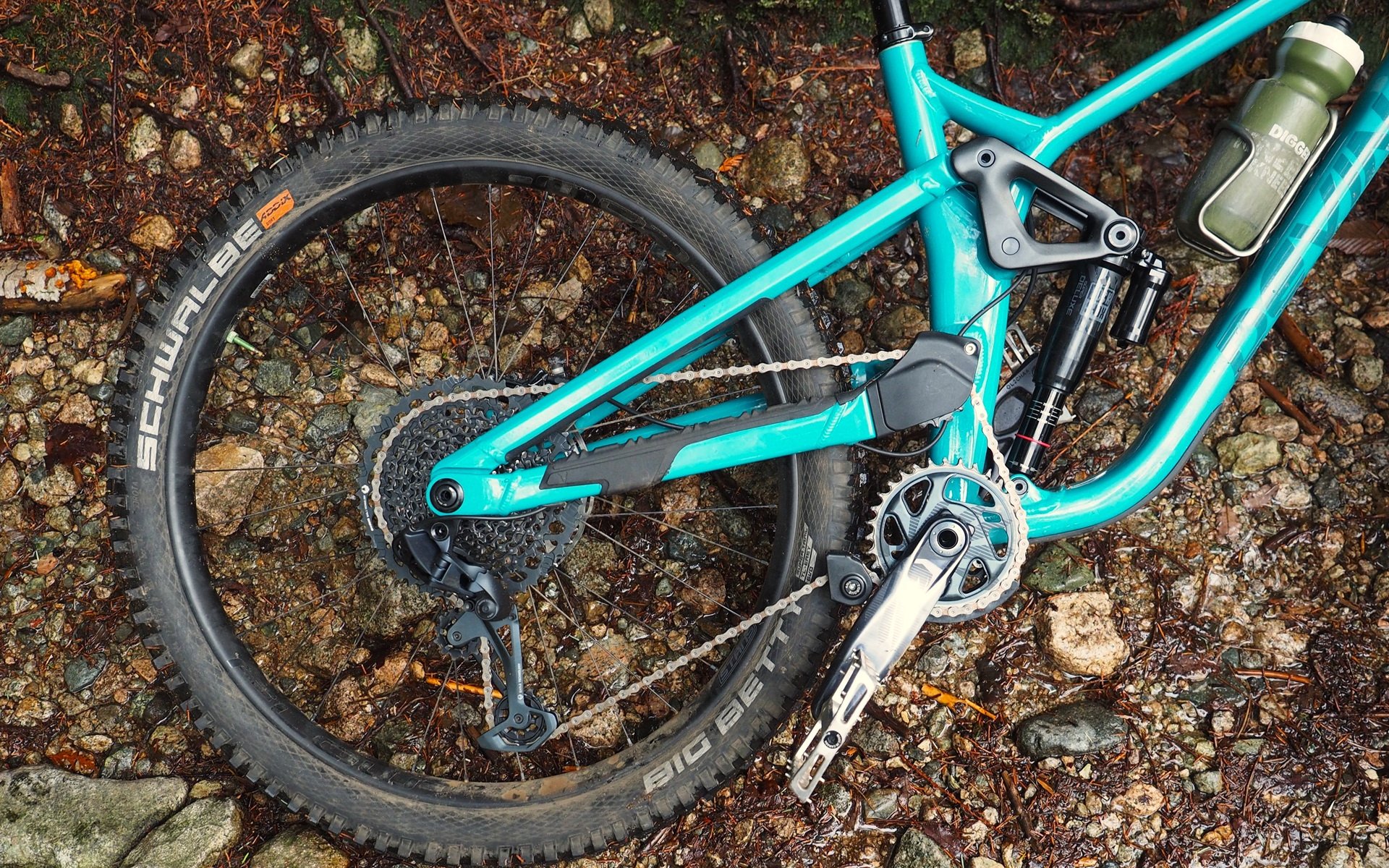
REVIEW
Devinci Chainsaw GX Part II - First Rides & Future Plans
In My Min-Max-Mix
Ignoring it's back-to-the-future High Pivot & Idler (HP+I) suspension design for a moment, the Devinci Chainsaw GX sits in a broad field of what I call 'realistic' bikes. To quickly explain, if it weren't for testing bikes and components, I see myself owning two rigs. My custom rigid single-speed and an N+1 full-suspension bike. And that full suspension bike would list for around 5K CAD.
If I had a significantly higher budget, then I'd be piecing together a custom bike from a frame-up. At a lower budget I'd only have my Waltworks with an extra suspension fork and multi-speed drivetrain to throw on when I fancied. But buying a complete bike at around 5K and selling the parts I don't want or need, often works out as a better min-max purchase than putting together a complete build.
I'd be swapping out the same parts on pretty much every stock bike no matter how much more than five grand I was spending. I'd be ditching the rear hub for one with much faster engagement and I'd be swapping the saddle, grips, and bar to my preference. When my budget allowed, I'd be buying a top-end set of after-market brakes.
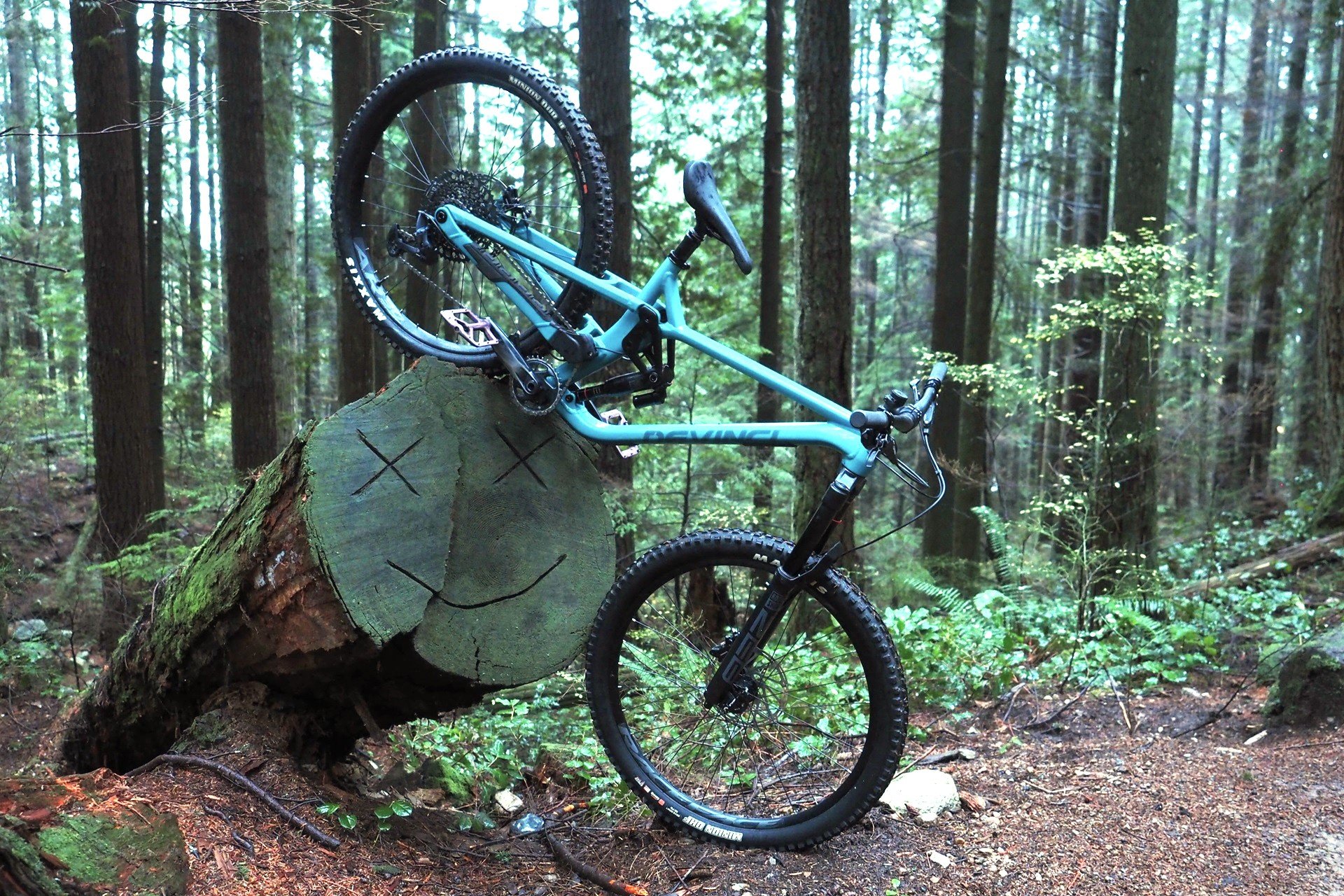
The Chainsaw GX with stock with dual 29" wheels.
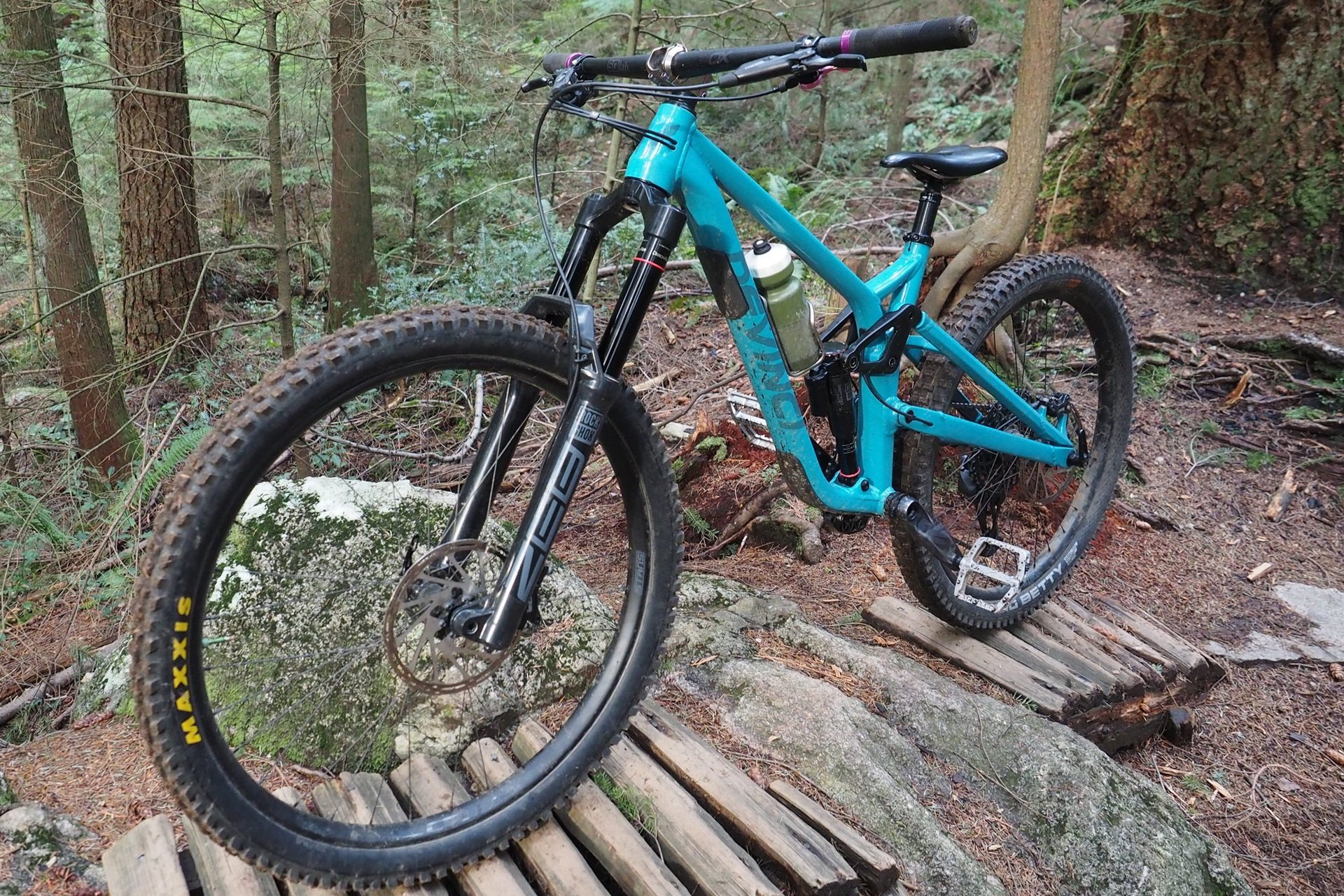
The Chainsaw GX as I'm riding it with mullet wheels (29" front / 27" rear).
This is a conversation I have with friends quite a lot and there is a range of bikes that are on my 5K list. I want to recognize that 5K, plus ongoing maintenance, is a privileged amount of money to be able to spend on a mountain bicycle, especially a second bicycle to pair with my rigid #1FG. But this seems to be the magic tipping point for a full-suspension rig where performance and durability stop improving exponentially by spending more cash.
My theoretical bike will have an aluminum frame with simple cable routing - internal or external - that does not interface with my headset and I'd like to be able to carry a water bottle in the front triangle. I'd prefer not to have in-frame storage but in most cases, it's not a total deal breaker. I've worked on a couple of bikes with storage hatches that rattle and all I can say is screw that.
I'm fairly suspension agnostic, I like what SR Suntour, RockShox, and Fox are doing in this price range. I'd plan to flip the brakes, but I understand that Shimano stoppers are the easiest to sell as take-offs. For drivetrain my first choice is Shimano Deore running on a HG driver, but I'm happy with the Chainsaw's GX drivetrain at this price.
Here's a short list of some examples of bikes that come up in conversation:
- Specialized Stumpjump EVO Comp Alloy
- Devinci Troy Aluminum GX
- Marin Alpine Trail XR
- Trek Fuel EX 8 Gen 6
- Rocky Mountain Altitude A50 or A30 Shimano
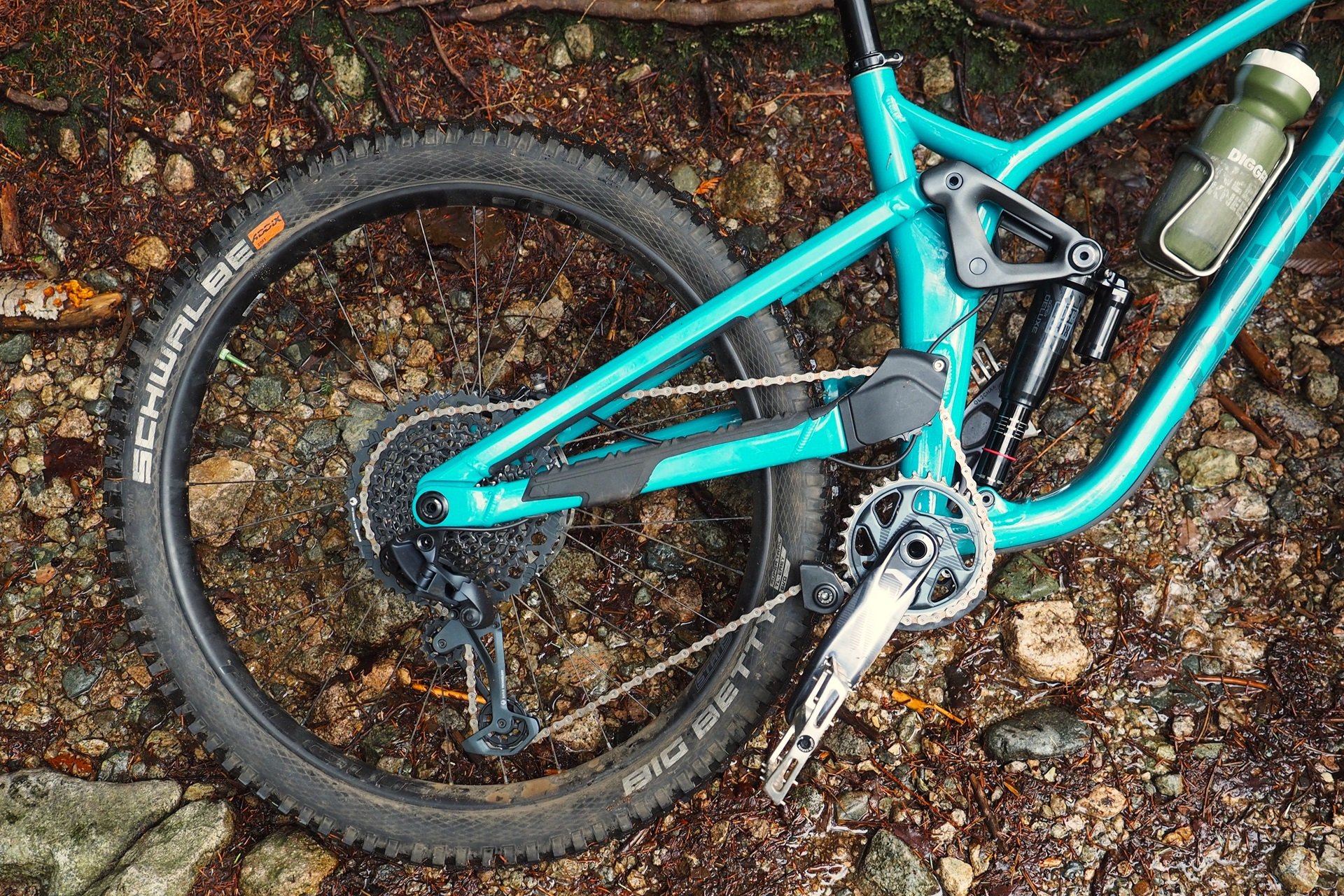
Prior to riding to the Chainsaw, a 170mm travel HP+I bike would not have been on my list of rigs I'd own.
It's Not A Troy
I don't know who all needs to hear this, but this bike is not a Devinci Troy. The Troy is a wicked all-arounder that mates a 150mm fork to a 140mm rear end. It has very balanced geometry and depending on brakes, tires, and maybe a centimetre of location-specific over or under-forking, I think it would make most riders happy in most places.
As my We Are One Arrival series suggests, I can't decide where I want to sit for a one bike choice between 140mm and 170mm of rear suspension. But, I know for certain that riders who frequent super-tight & twisty trails or are getting jibby-with-it on blue-flow trails are going to be much happier with a Troy.
As I noted in my first impressions piece, I was eager to write something about the Chainsaw, but more than a bit trepidatious about riding and reviewing it. It certainly doesn't look anything like the bikes in my short list above. After a couple of rides and a few key changes, I must admit I'm scheming to keep it longer.
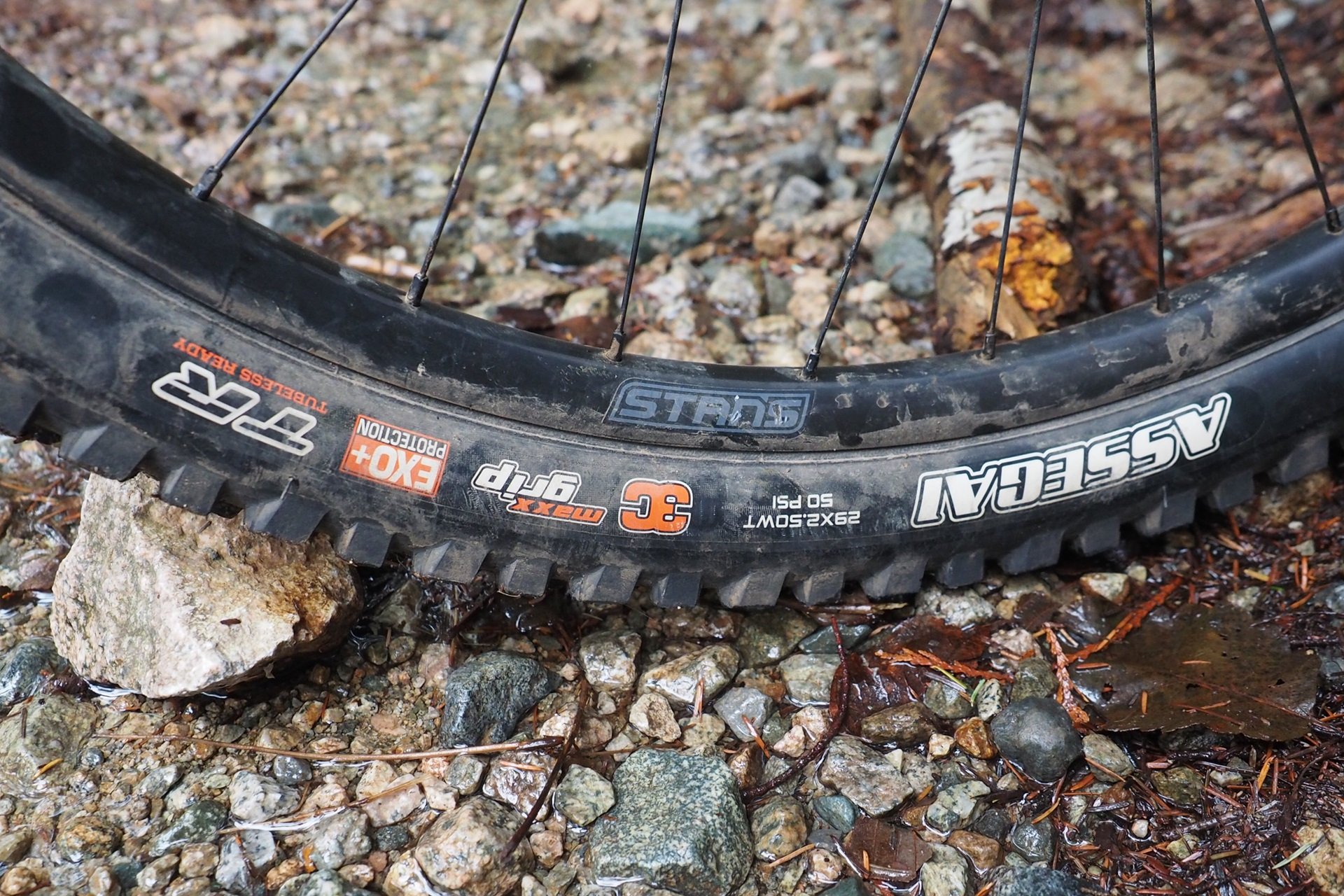
I'm running a 29x2.5" MaxxGrip Assegai EXO+ with a CushCore Trail insert in the front.
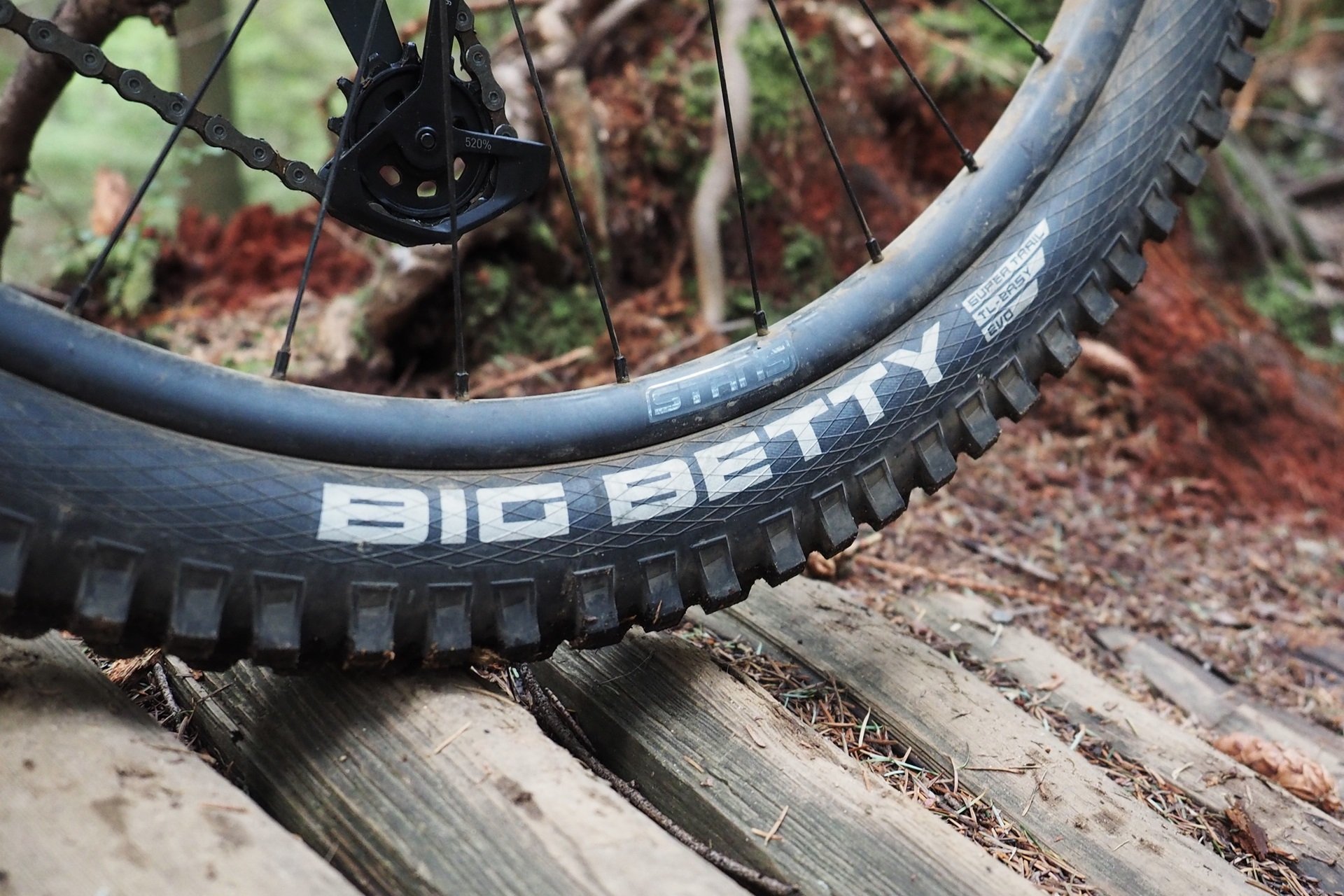
Out back is a 27 x 2.6" Addix Soft Big Betty in Schwalbe's Super Trail sidewall, also with a CushCore Trail insert.
Fit Bits
RaceFace 35mm bars don't work well for me, so I immediately swapped it for a smoother riding 31.8mm bar with a sweep I prefer. This also necessitated a different stem and as I'll discuss later I'll be jumping back and forth between 40mm and 50mm lengths. I swapped the saddle out to a WTB Deva, which I had on hand and which happens to be one of my all-time favourites. I also changed out the grips to ones I prefer. These are all changes I'd expect to make on any machine at pretty much any price point.
On a bike for 5K I'd also expect to be changing the dropper post remote, along with grips, saddle, and adding pedals. Contact points! It's remarkable how much better a budget dropper post feels with a nice remote.
I'm never chasing the longest dropper post options, but the 150mm that's stock on the Chainsaw this year is a bit short when the trails get slow and steep. I swapped it out for a 175mm dropper and I'm happy. There's plenty of room for a longer dropper post yet, even without switching to a Wolf Tooth or OneUp post to maximize the drop for a given insertion depth and stack height.
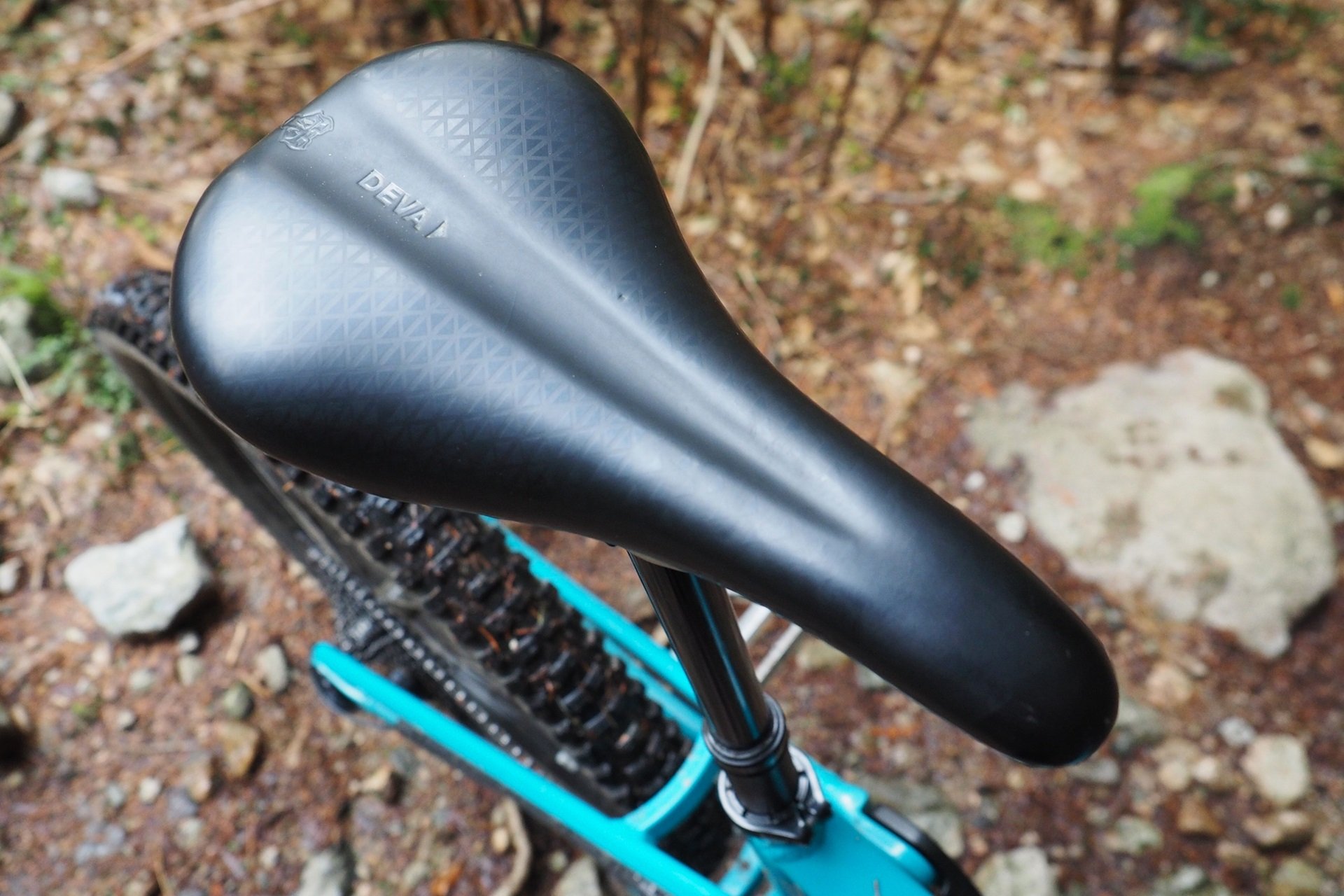
Classic WTB Deva saddle. Run fairly rearwards in the seat post clamp.
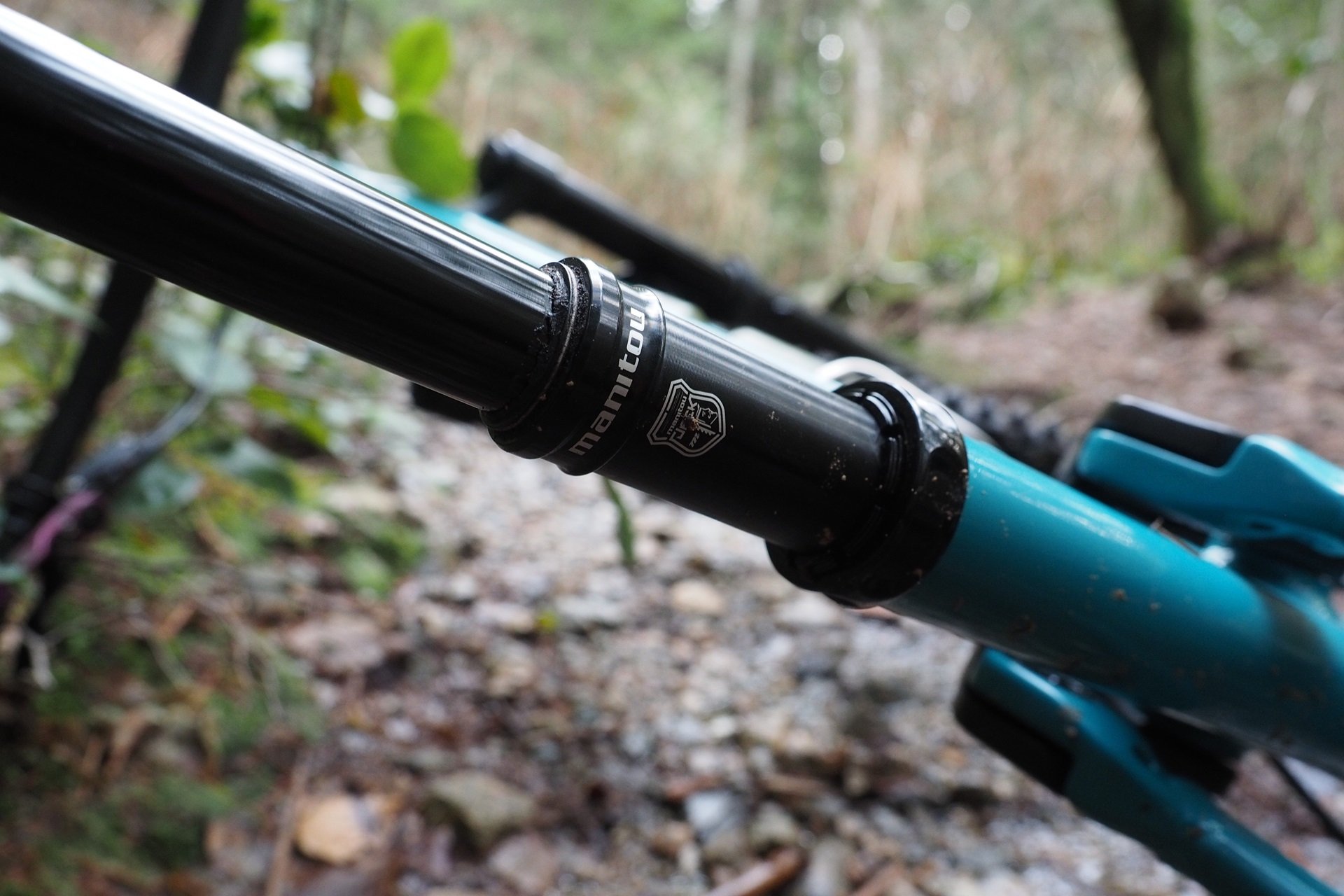
Manitou Jack / BikeYoke Revive dropper post set at 175mm travel.
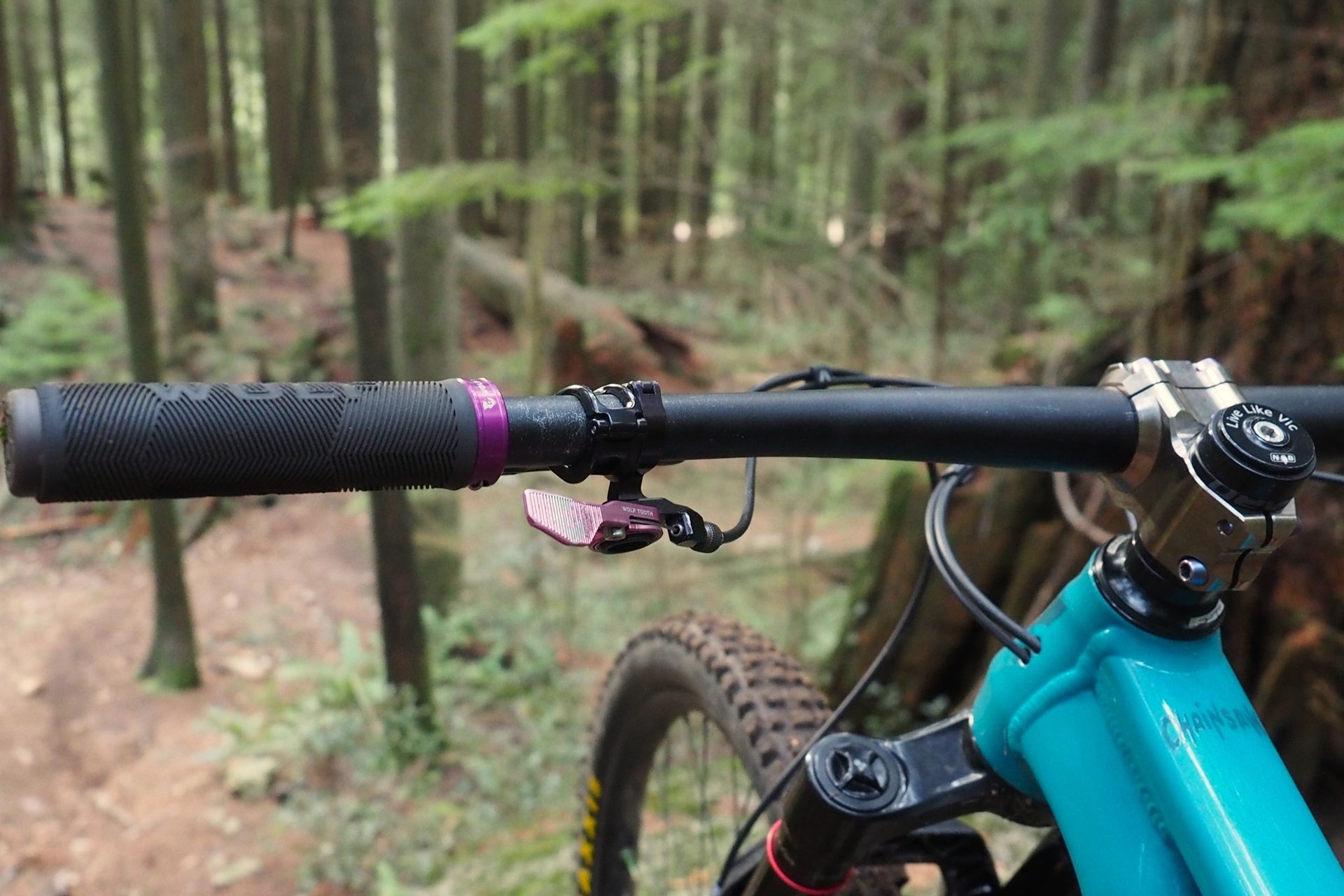
My grips, dropper remote, bar, stem, and headset top cap.
DH Bike Climbing Notes
I have no real complaints about climbing the Chainsaw, which surprised me considering the two extra jockey wheels on top of the rear derailleur and a bunch of travel. After a few trips up No Quarter, I can say that the riding position works well with sag, and the bike motors along admirably for a strongly DH-biased 170mm platform, but it's no WeR1 Arrival A170 in this regard. I questioned the lack of a lockout lever on the Select-level RockShox shock earlier, but I no longer lament the feature's absence.
I made one helpful change right away, which was to ditch the annoyingly loud and draggy e13 guide for a Deviate version that runs more smoothly. I was also happy to have the Deviate's bash taco. I know the e13 is a price-point choice, but I'd love to see Devinci spec. the new MRP MXg high pivot-specific guide, with bash taco, that comes on the Trek Slash.
With where the idler sits behind the chainring, a rider desperate to ditch the lower guide pulley could get away without it as long as their narrow-wide chainring is in good condition. The real negatives to running it, and the top pulley in the HP+I setup, is that they limit the length the chain has to bend through to interface with the Chainsaw's lowest gears. I'm already not a fan of the chain lines on most bikes in the lowest couple of gears on any 1x12 drivetrain and every HP+I setup I've seen makes it a little bit worse.
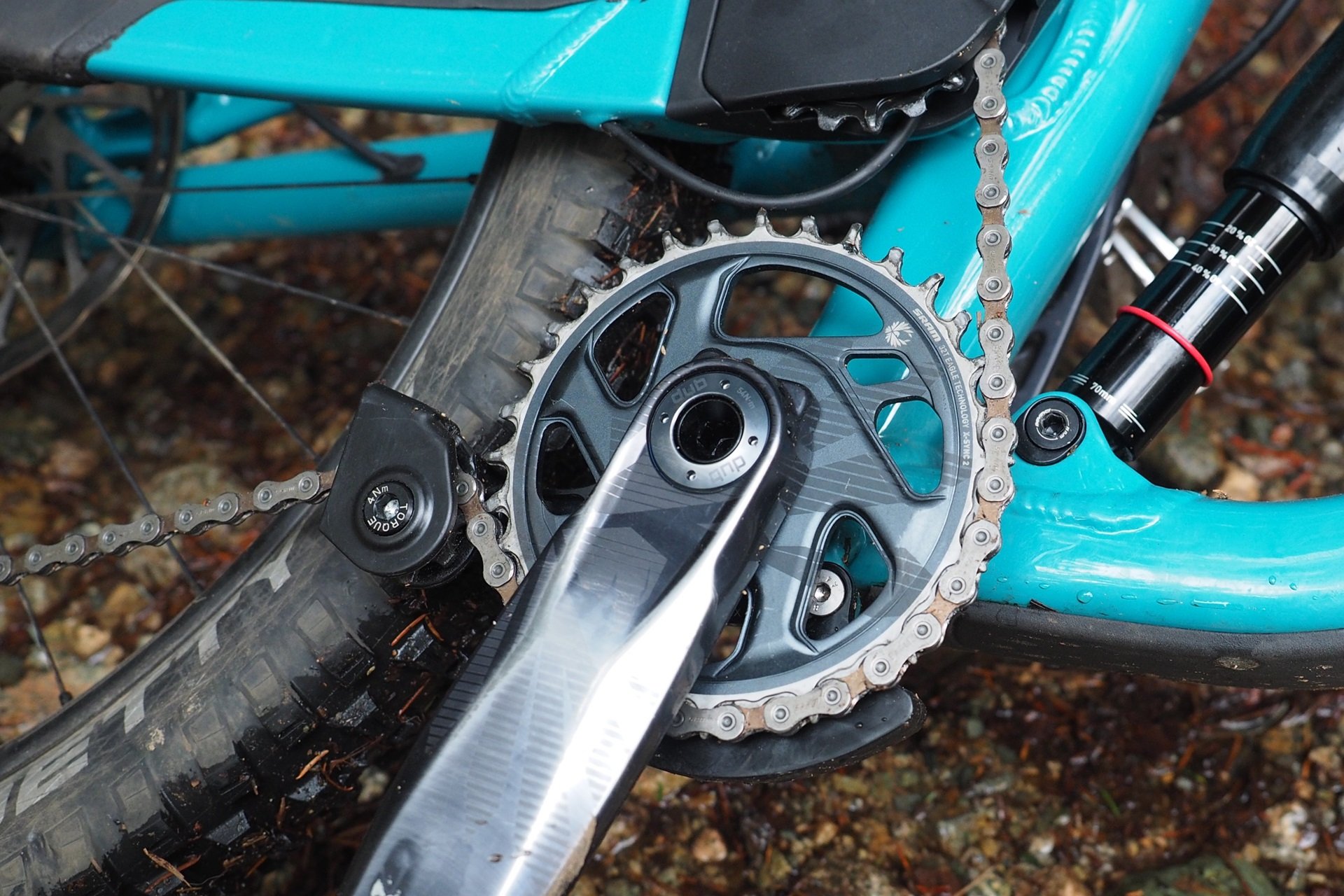
Swapping the e13 lower chain guide for a Deviate unit notably reduced noise and drag. I've also tagged the bash taco a few times already, so I'm happy it's there.
The Chainsaw, like most modern longer-travel bikes, pedals quite well seated. The uphill handling is what you'd probably expect from a long squishy bike with a <63° head tube angle that's only getting slacker as the climbs get steeper. Tight uphill switchbacks are, of course, the biggest challenge. I find moving my hands inboard on my bars helps reduce oversteering. Other than tagging my, thankfully armoured, knee on my shifter occasionally when the climbs get properly tight the Chainsaw and I are just getting it done.
I'm always wary of overstating the climbing chops of a DH-focused bike, especially as I know everyone's fitness, strength, and tolerance level are quite different. I will say that I came into this review assuming the Chainsaw would be an N+1 bike for most riders and that assumption was quickly disproven. I know several pedal-and-plunge riders on the Shore who could enjoy this rig as their only mountain bike.
One other note re. climbing. As is my preference, I'm running a much faster-engaging hub than what's featured on the stock wheelset. The Stan's/P321 M-Pulse hub collaboration in the Stan's Flow wheels I'm reviewing has 1.66° engagement.
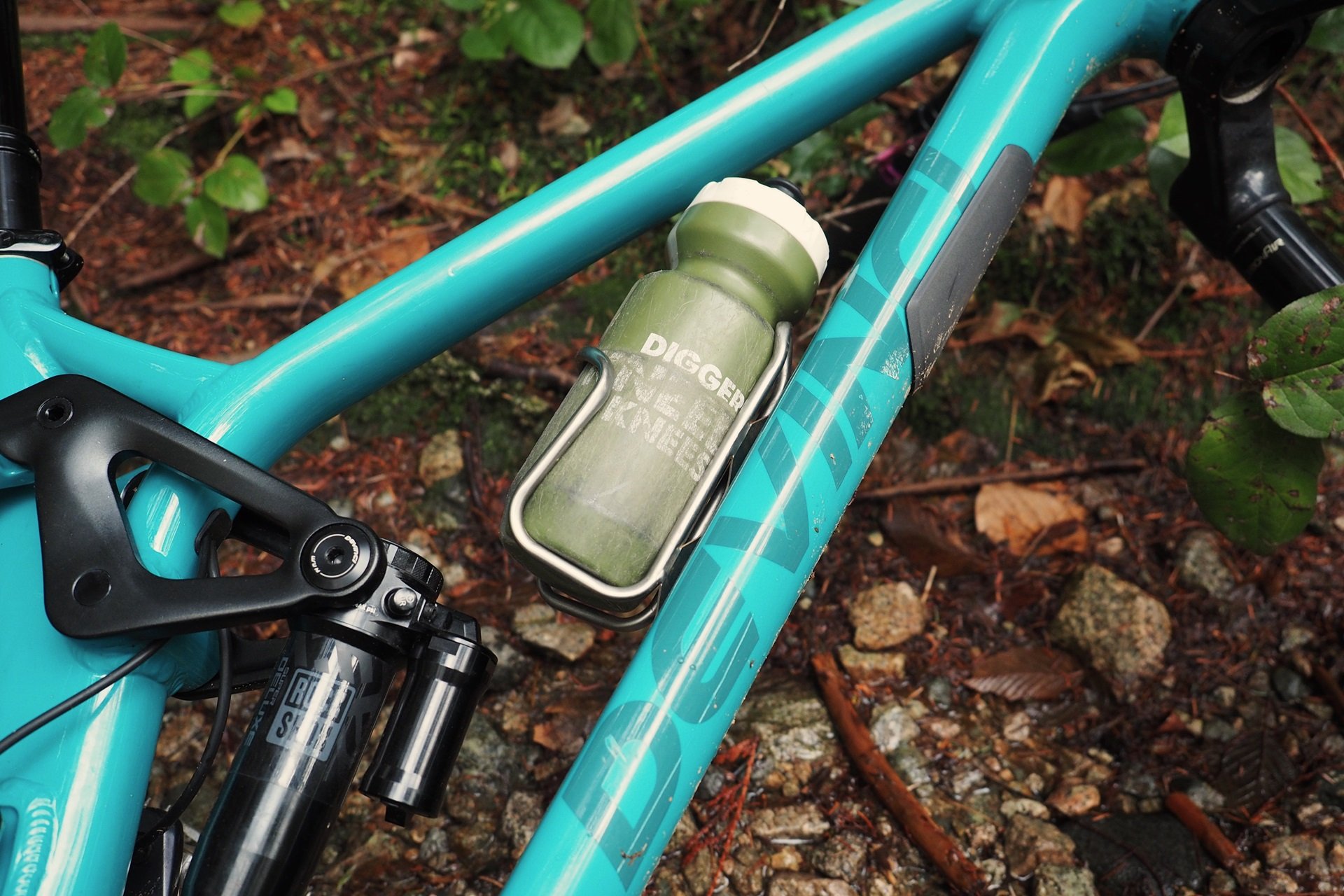
Devinci would probably have an easier time selling the Chainsaw GX with a Select+ shock, featuring a lockout lever, but I don't miss the feature at all.
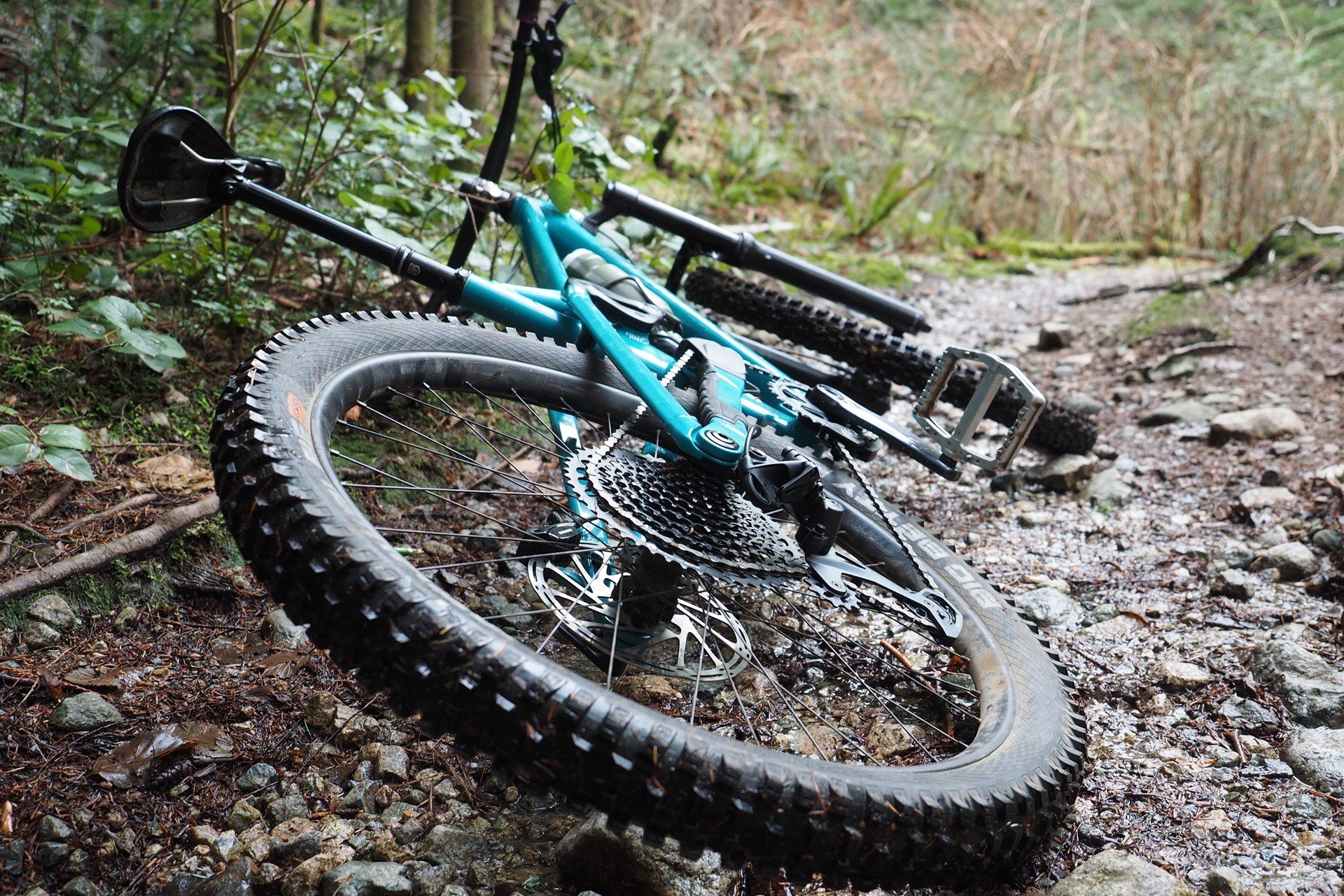
Contrary to my initial assumption about the N+1 nature of the Chainsaw's HP+I suspension, I'm quite happy to take it on long and steep climbs.
DTFHFG?
The Chainsaw rewards a sit-and-spin riding style but between the weight and travel of the rig, and the steepness of my preferred local climbs, that has me using the lowest three gears a lot. With the chain captured by jockey wheels top and bottom, the chain is forced to bend aggressively with so much of its length being captured by the idlers making for an awkward chain line.
The simplest solution is to swap in a smaller chainring and spend more time pedaling in the middle of the cassette, but then I don't need the extra range and weight of the massive low gears, I just want a straighter chainline. The beauty of an HP+I design is that the suspension should be unaffected by chainring size, so when it comes to this Devinci, the answer to the question 'Does The Future Have Fewer Gears?' is yes.
I'm going to leave more discussion of my plans for the pending tenth installment in the 'DTFHFG?' series but to answer folks who are immediately thinking that a significantly smaller chainring would be fine for the Shore but limiting in the bike park, I'd suggest it's a fast and easy job to swap a ring and a chain for those two unique use cases.
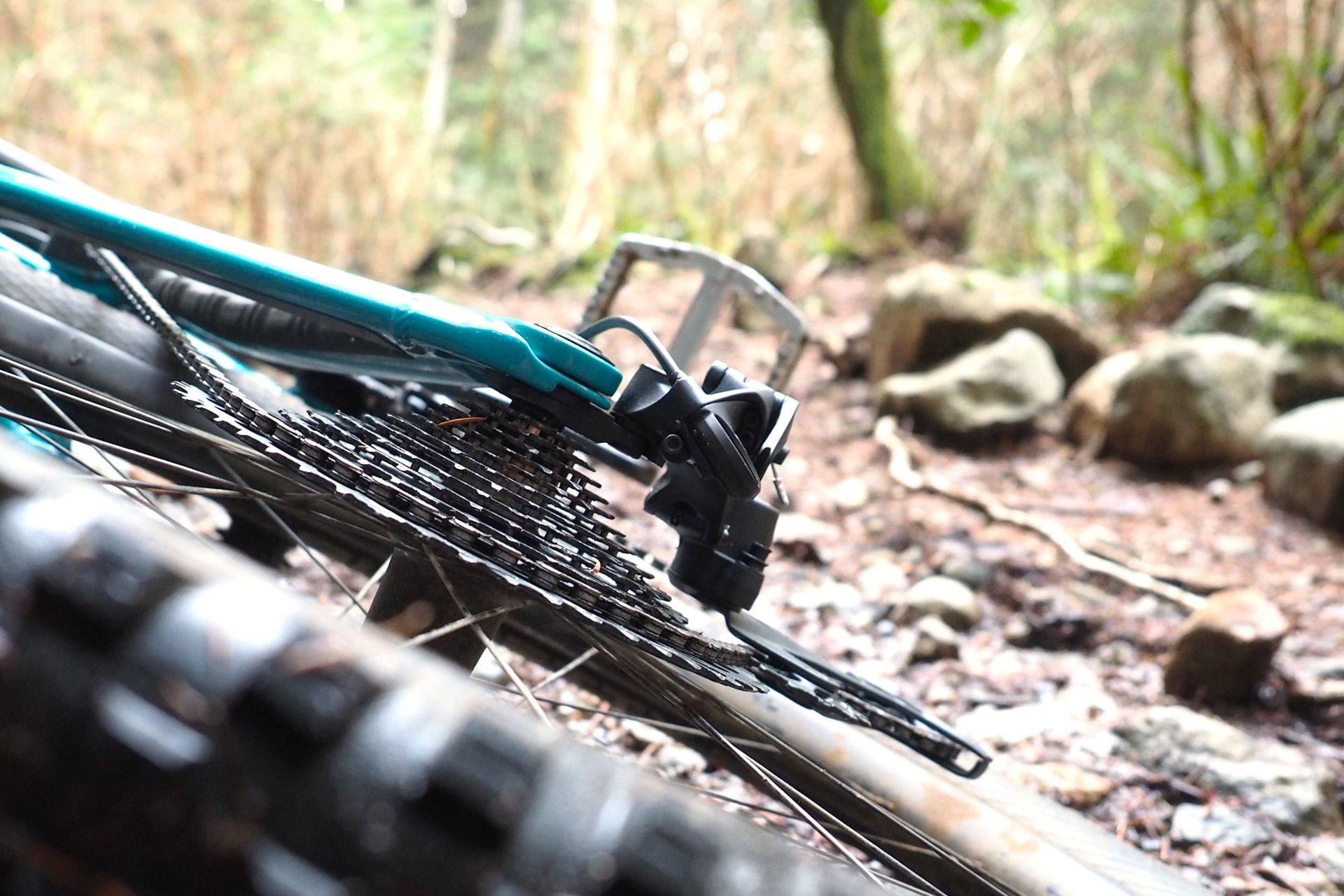
Chainlines in the low gears aren't great with any 12-spd drivetrain, but the way HP+I bikes capture the chain on jockey wheels top and bottom makes things worse.
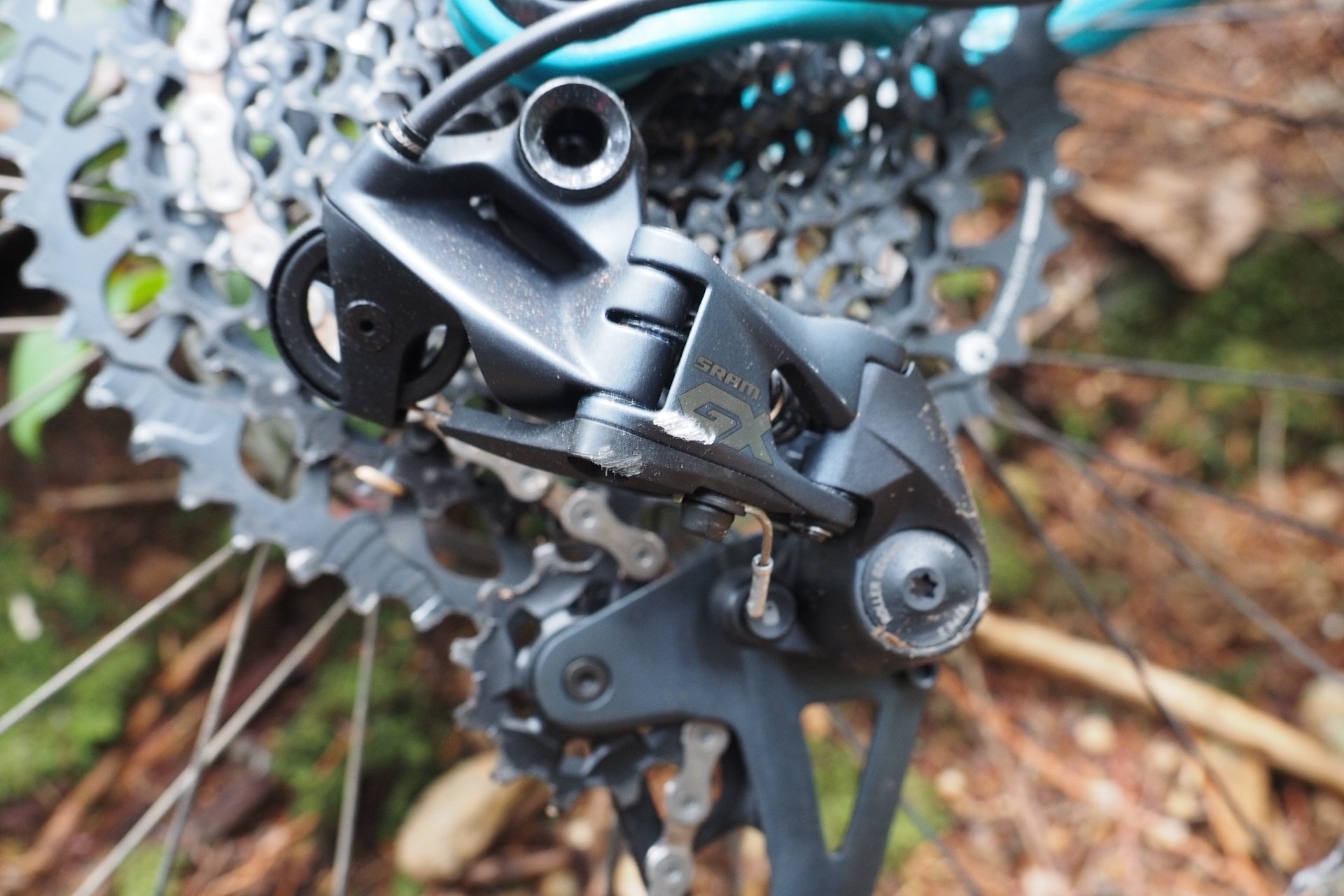
I seem to smoke my rear derailleur significantly more often on bikes using Super Boost-157mm rear spacing compared to Boost-148mm rear spacing.
Descending Notes
Pedaling up the trail on my first ride on the Chainsaw, I was convincing myself that I should be on a large rather than this medium. Not that the medium didn't fit per se, but that I'd be more aggressive climbing stretched over the extra reach of the large frame. With the huge difference in sizing between the medium and large, I started picturing myself on a medium-large that I would love to see the brand make.
On the way back down it only took a few sketchy sections to find myself singing a different tune. The medium Chainsaw is plenty stable with its 1257mm wheelbase and its elongating from static 430mm chain stays, and I have to actively work my 5'9" frame and T-Rex arms to weight the front wheel with the, again static, 62.9° HTA. I don't mean that in a bad way at all; the Devinci wants to be f*cking ridden. With a few rides under my feet, I'm confident that of the options available I'm wielding the correct size in terms of maximizing my fun and confidence.
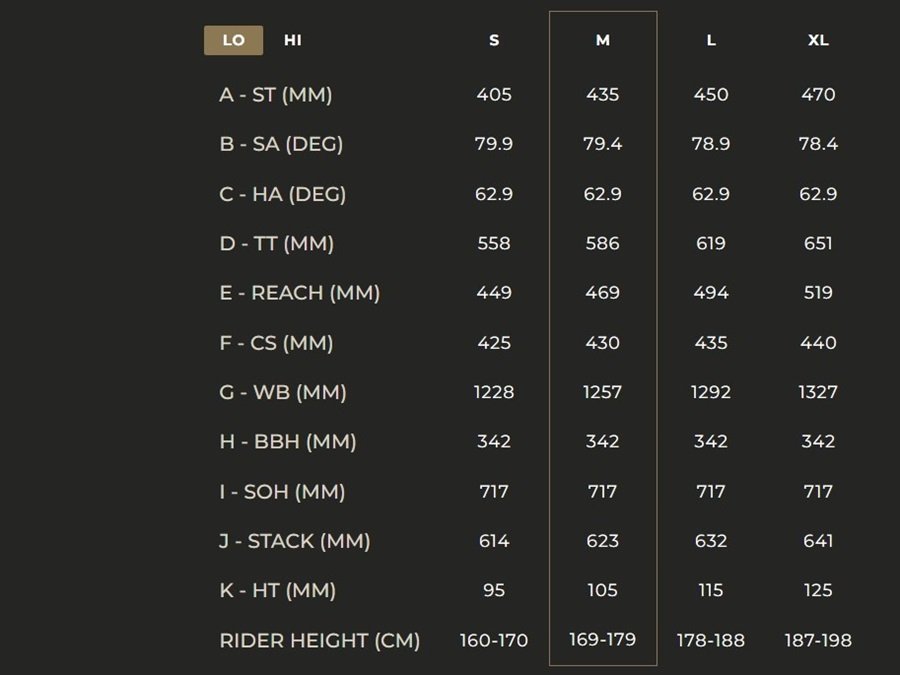
I'm running the high position but with a mullet wheelset, which should approximate the low geometry with dual 29" wheels.
It will come as no surprise when I say that the 'Hype Pivot' rig eats bumps. Especially, big chunky gnarly square bumps mixed with a bit of straight-line speed. The Chainsaw prefers to stay planted to the ground and go fast. I'll have more to say about this in my final review as I'm still playing around quite a bit with suspension settings.
On that note, where some bikes like to be run with a precise amount of sag, the HP+I and Split Pivot suspension on the Devinci seem ambivalent. I could see this bike working for riders who like to run a lot of sag and max out the tokens in their air spring, and it certainly works for me running a firmer setup. I'll come up with numbers for the final installment.
I'd love the opportunity to run a higher-end, more adjustable, shock on the Chainsaw but only because the basic Select-level Super Deluxe (SDS) feels fantastic on this bike and I'd enjoy making the comparison. The SDS is smooth off the top and from sag, and there's nothing weird happening at any point between the initial travel and a gentle bottom out.
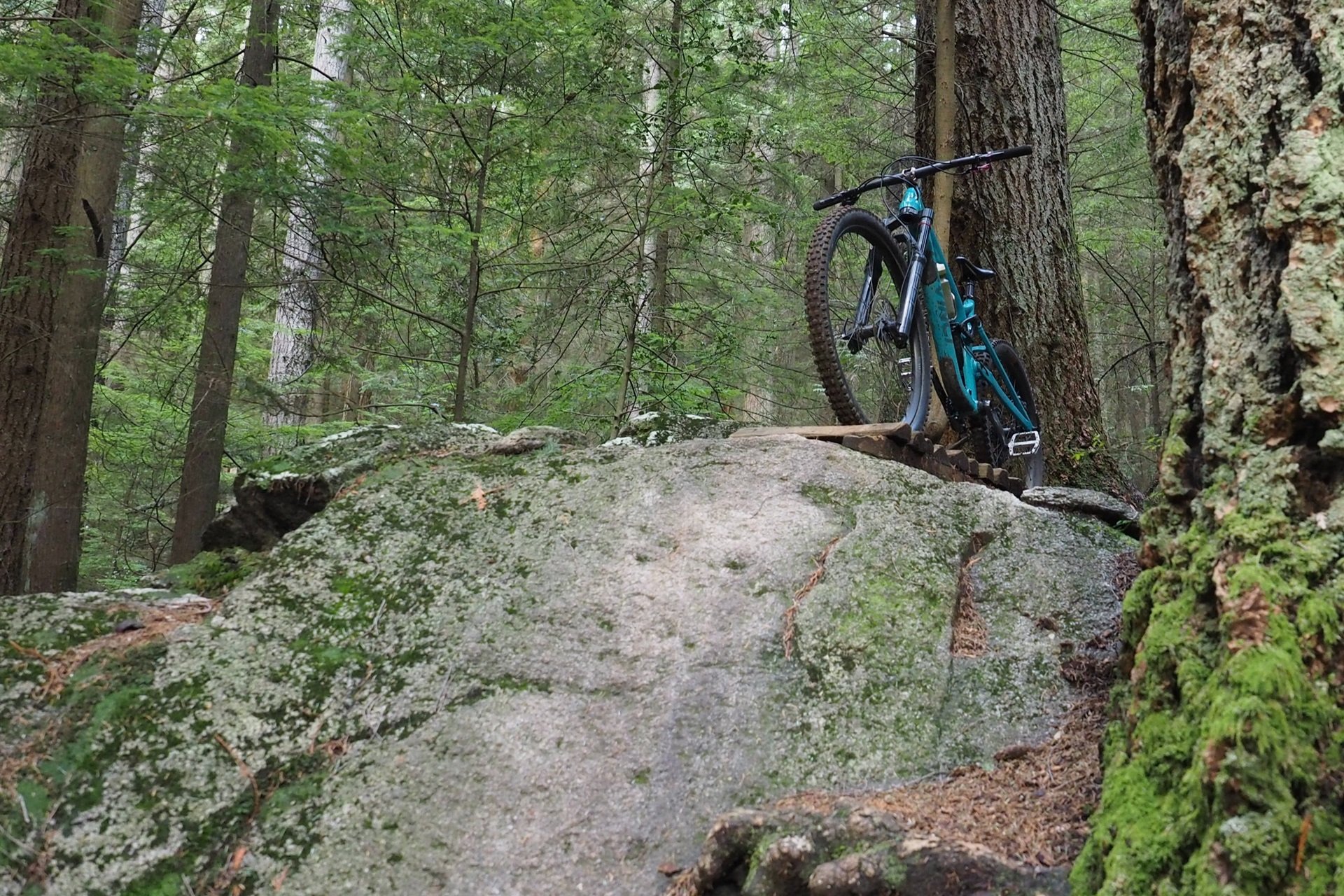
The lowest-end, OE-only, Zeb 'Base' fork and its basic Rush RC damper are working well for me. The Zeb chassis is an excellent candidate for a damper upgrade all the same.

Thus far, the basic Super Deluxe Select shock from RockShox is awesome paired with the Chainsaw's HP+I Split Pivot suspension system.
A couple of notes on the fork. This 170mm Zeb is the most basic platform in the lineup and it uses the RockShox Rush RC damper. The Rush RC sits below the Charger RC but both are IFP dampers with adjustable low-speed compression and rebound. This is the first Rush RC fork I've ridden, but I've been on plenty of RockShox Zeb forks with the Charger RC damper and I can't tell the difference.
For folks that want more adjustment, it's easy enough to upgrade this chassis to the top-end Charger 3 RC2 unit that ships in Ultimate and Select+ level forks. I've also had excellent experiences with Avalanche DH Racing dampers in the past, though I haven't played with one paired with the latest Debonair+ air systems.
I am finding that balancing it with the rear end is a little bit of a battle. Rather than being a complaint about the fork I think it's down to how dialed in the Chainsaw's rear suspension feels when trails get hold-on-fast & rough. This may come down to the amount of travel rather than the sophistication of the damper and I wonder if bumping the fork up to 180mm or 190mm travel would make it feel more balanced.
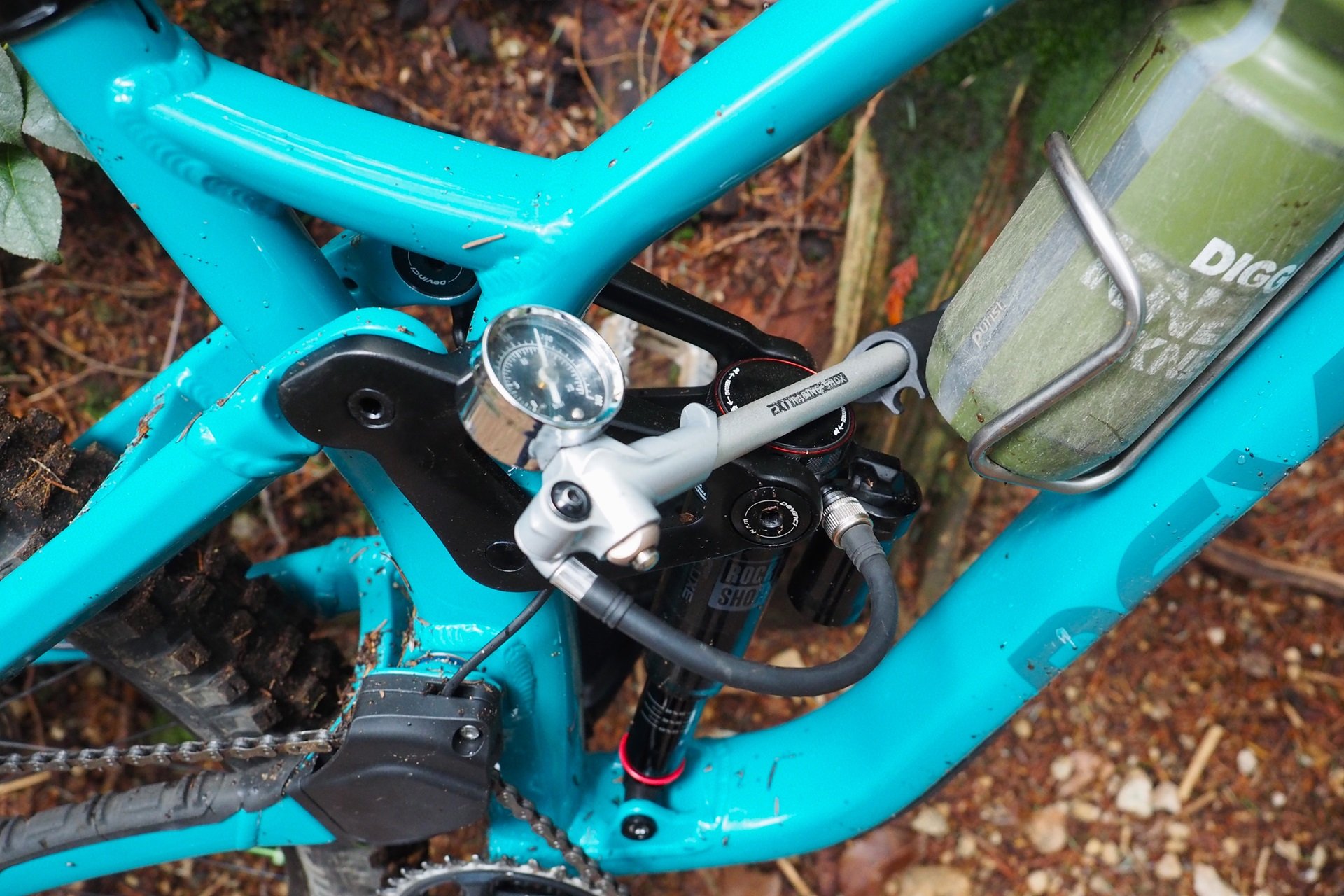
I've yet to full settle on how much sag I want to run with the Chainsaw. I've ridden it on faster more open trails, and on the steep slow janky trails that I love.
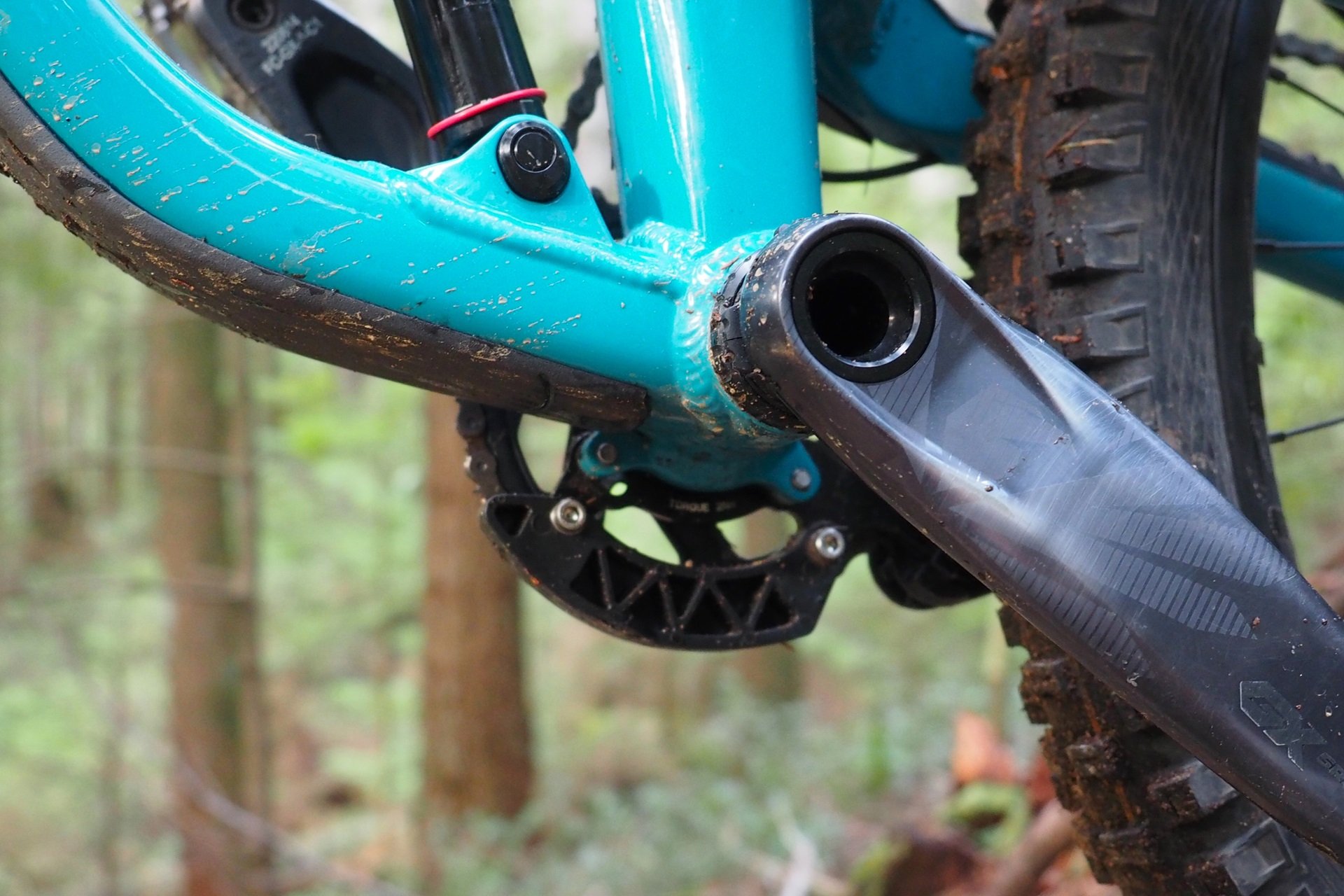
The Chainsaw's bottom bracket height isn't particularly low but I still think Devinci should be shipping these with a lower chain guide that includes a bash guard.
Braking News
In my first look, I mentioned that the G2 RE brakes on the Chainsaw GX make sense from a cost perspective, 'feel' better than SRAM Code R brakes, and offer reasonable power thanks to the use of an older generation Code caliper mated to the current G2 master cylinder.
They're okay. But as with every bike on my list at this price, a brake replacement would be an upgrade that I'm keen to engage ASAP. For me, that would mean an investment in a set of Formula Cura 4 brakes with their 2pc lever upgrade or a pair of Hayes Dominion 4-piston brakes.
I've been thinking about reviewing bikes a fair bit lately, and I know brakes regularly come up as a detraction, and distraction, in my pieces, so to rectify that I have a set of Dominion brakes that I'll be using as a control with any bikes I review going forward, including this Chainsaw. In hindsight, I wish I'd done said swap with the Arrival as well.
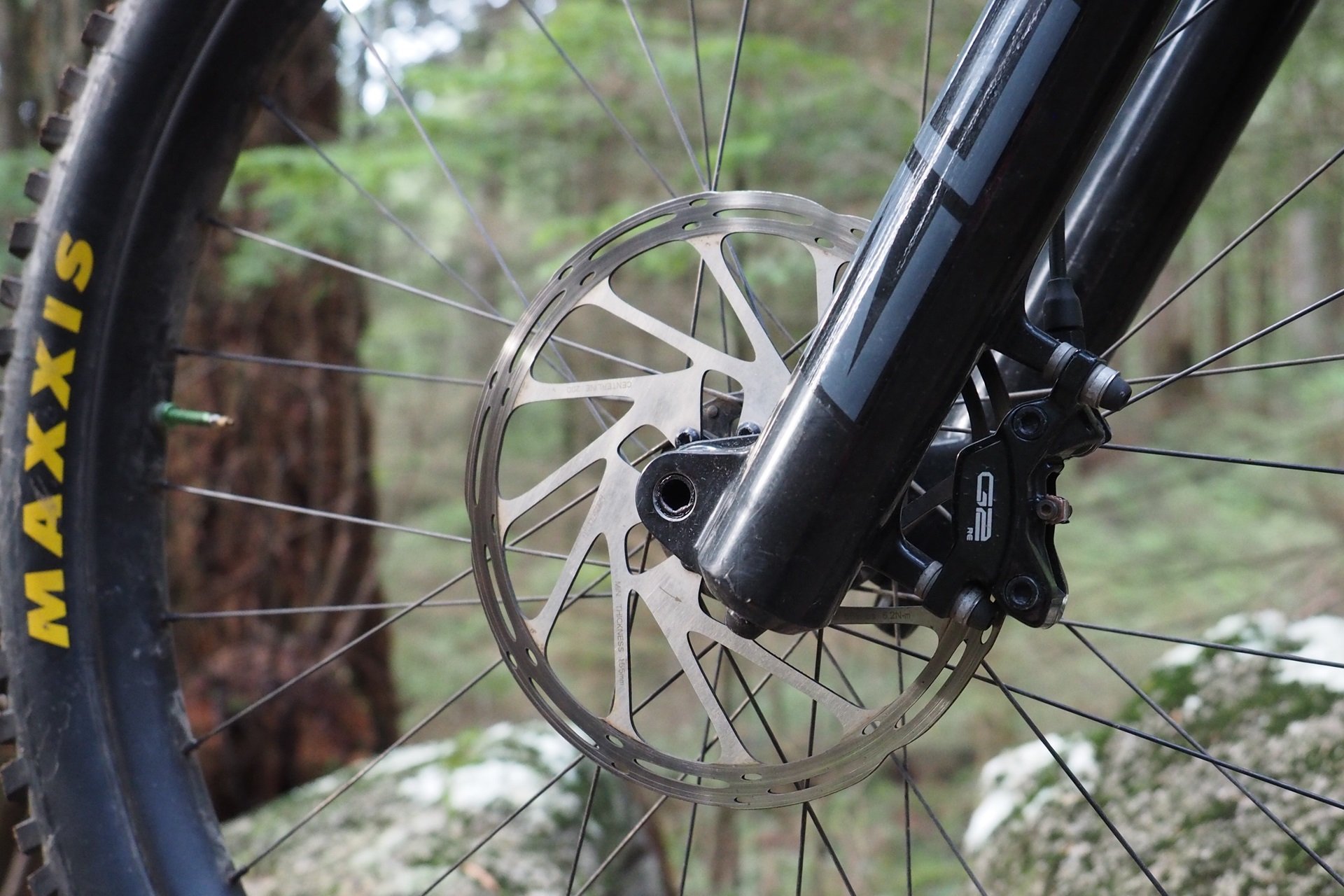
The G2 RE brakes are a price point option that seeks to min-max feel, power, and price. They're okay, which is how I feel about most brakes on 5K CAD rigs.
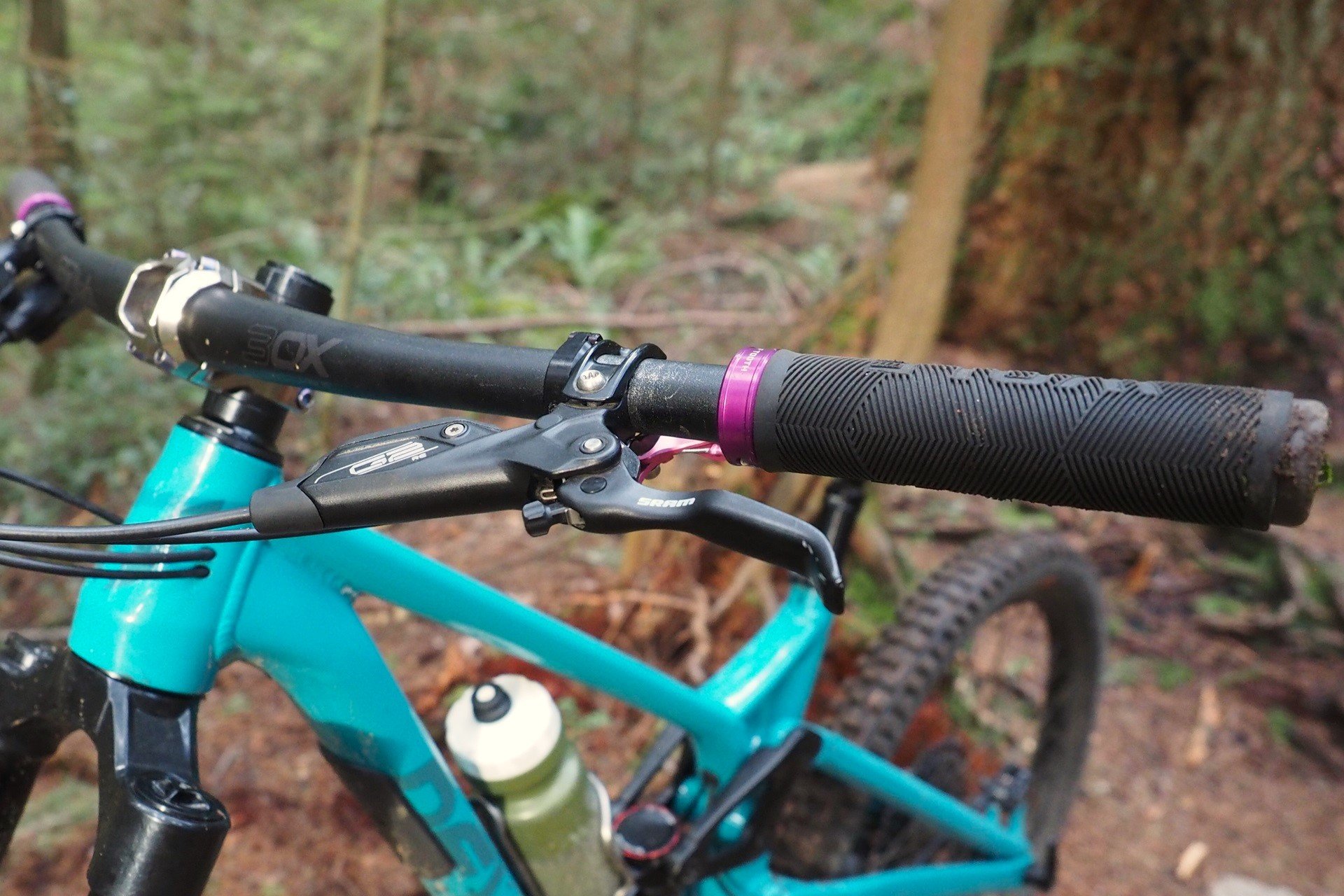
I use amazing brakes on my bikes, and they make every difference for me riding the Shore with my abilities. So I'll be swapping these out for the remainder of my review.
Deep Cuts
With the relatively long wheelbase and truly slack HTA, I have to make sure I'm tuned in and focused on weighting the front wheel when I drop the Chainsaw into steep sections of trail. Well, at least it's not intuitive to date. Historically though it takes me quite a few rides to fully get in synch with a bike. The Super-Enduro or Enduro+ category, which are basically DH bikes that can be pedaled, isn't something I dabble in very often either.
Speaking of basic, folks keep telling me how complicated the Chainsaw looks, but it's just a linkage-driven single-pivot bike. Yes, with Split Pivot the seat stay pivot is moved to the axle, but otherwise, all that's extra here is the jockey wheel, AKA idler, at the main pivot location. Devinci has used big bearings that look well-protected, and there have been lots of articles about this rig, but if anyone would find a teardown helpful, let me know and I'll try to make that happen as part of the final piece.
In the meantime, what better mountain bike pairing in a stable than a fully rigid single-speed and an HP+I single crown DH rig?
Height - Steve Buscemi-ish
Wait - Patiently
Ape Index - T-Rex
Age - The same as DOS
Favourite Trail(s) every week - Pipeline (thank you Ken!) to Lower Crippler (thank you Andy!)
Favourite Song(s) this week - I'm Your Man. Nick Cave (covering Leonard Cohen)
Favourite Colour - Cosmic Lilac
Bar Width - It depends
Reach & Stack & ETT - It depends
Crank Length - 175mm except when it's 170mm
Wheel Size - Hot For Mullets
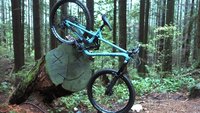
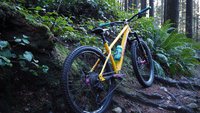
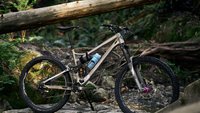
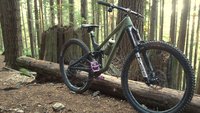







Comments
Lu Kz
3 months, 2 weeks ago
The future has fewer gears, but we might add back the missing cogs through various idlers and guides.
Reply
Andrew Major
3 months, 2 weeks ago
I assumed this was going to be the first comment!
I think a bike where the chain is captured top and bottom is even more a candidate for DTFHFG in terms of the potential benefits (I mean, I can confirm this already - the straighter chainline in low gears makes an amazing difference). It’s not like DTFHFG really makes a bike simpler anyways - it’s not a single speed, there’s still a derailleur, shifter, cassette, and chain.
But yes, trading three cogs for two idlers is something different.
Reply
Lu Kz
3 months, 2 weeks ago
Damn, baited again. Well played, Mr. Major.
Reply
Andrew Major
3 months, 2 weeks ago
Hahahaha. Thanks for playing!
Reply
MTBrent
3 months, 2 weeks ago
I may not ever buy this bike, but I always enjoy and get something out of your teardown pieces, Andrew. So, I'm letting you know!
Reply
Andrew Major
3 months, 2 weeks ago
Cheers!
Some disassembly required.
Reply
Allen Lloyd
3 months, 2 weeks ago
This being a potential only bike is music to my ears. I bought a Stumpjumper (the basic alloy cheapest suspension thing in the shop version) for my son a couple years ago and after riding it a couple of times discovered that the modern geometry makes for an amazingly versatile bike. Over time it has become my main bike. My other bike is a V1 Hightower that is better for jumps, but lags in all other situations.
Where the Stumpjumper fails is at the bike park. Something like this that could take the bike park and normal all mountain riding sounds perfect for what I need these days. I always sit and spin so hearing that is the preferred climbing sounds good to me. My out of the box upgrades mirror yours I wouldn't even bed in the pads on those brakes. We have been working on getting all our bikes on Shimano for brakes and drivetrains. The new heavy but cheap Shimano stuff is great for this and would be a first winter upgrade.
The one thing I don't do is upgrade wheels. I have a spare set and have employed a see if I can destroy the cheap wheels approach. So far again I have been amazed at how capable a modern mountain bike is, even the cheapest version.
Reply
Andrew Major
3 months, 2 weeks ago
If it wasn’t for wanting to mullet the bike I wouldn’t have swapped the wheels, I just would have added CushCore inserts to the RaceFace AR rims.
I am much happier with the super-fast engaging hub on the climbs, and would make that upgrade on my own bike, but can easily manage for a review.
.
I’ve done the brakes now and the DTFHFG drivetrain install. Swapping out the e13 chain guide can’t be overstated for the improvement but the straighter chainline for the low gears is amazing too.
Reply
Andrew Major
3 months, 2 weeks ago
It’s funny, I know a lot of folks who are heavy on with the standardized fleet goals. Like the whole family rides Codes with the same sized rotors and if one bike goes to 12-spd they all go 12-spd. Inter-swappability is a key goal.
My family are all on 11-spd chains (mountain bikes and commuters) but from there it is a rolling sh*t show of SRAM, Shimano HG, Shimano LG, and ShiRAMano in Claire’s case for drivetrains. No two bikes have the same number of shifter clicks. My Wife loves her HC-lever Magura brakes (small hands) and Claire’s on a friend’s used Guide brakes. I’m running Hayes, Formula, and have a set of original MT7 brakes as a backup.
Reply
Morgan Heater
3 months, 2 weeks ago
In a perfect world, i'd have my family standardized on hubs and wheelsize, but I don't even have that right now.
Reply
Andrew Major
3 months, 2 weeks ago
Haha. Claire’s on 24”, Nina’s on 27+, I’m on 29/27 and 29+/27. So interchangeable hubs isn’t a huge deal to me. Always have a few Boostinator kits around anyway.
All 31.8 bars except for WZRD one-piece. But both of them run too narrow for me to go thieving.
Reply
Skooks
3 months, 2 weeks ago
I'm getting close to standardizing the fleet. *All* our bikes run Shimano brakes and drivetrains. All MTB's are 11-speed HG standard, and all road bikes are 10-speed. My wife runs 27.5 wheels, but they use the same rotor size as my 29er wheels. I am a Knolly fan, so all of my mountain bikes run 157mm rear hubs. All the dropper posts in the fleet are OneUps. It definitely makes it easier to keep things rolling when you have lots of cross-compatibility.
Reply
Andrew Major
3 months, 2 weeks ago
I’m making an ‘ick’ face while I write this, and certainly I’ve been joking a lot that it’s an industry jobs program to sell epically more rear derailleurs (as I seem to smoke mine every ride), but I think buying an SB-157 bike is an increasingly smart move for folks looking to future proof from now (as opposed to moving current B-148 wheels over to a new bike).
There’s potential for better chainline while giving bike designers more room to package suspension and cable routing (and motors).
I don’t know who’ll be the first big brand to make a switch - and again I’m not advocating for SB-157 / if I was king of bikes there’d be fewer gear ratios and external routing - but I’d guess at this point Pivot/Devinci/Knolly/etc are already practicing their gracious ‘We were right’ speeches.
Also, while I don’t know which big brand will switch first I do know that no brand will want to be last. So if/when the change comes it’ll be quick.
Reply
Timer
3 months, 2 weeks ago
On the other hand, it’s a buyers market right now and pissing of customers with yet another incompatible standard with questionable benefits might not be quite the winning move.
Reply
Andrew Major
3 months, 2 weeks ago
Again, I’m not intending to advocate for SB-157. For the trail bikes and hardtails I ride B-148 is fine. I’d certainly prefer B-148 or even old 142mm spacing for the hardtail.
Trek managed to package the new HP+I Slash with a 55mm chain line / B-148 drivetrain, so I’m not even claiming Devinci needed to use SB-157 for the Chainsaw.
But, by my math the Devinci has a better chainline by 3mm, with its 56.5mm chainline mated to a SB-157 rear end and that’s not nothing for someone who will be grinding low gears.
I think with more and more bikes using 55mm (instead of the B-148 standard 52mm) chainlines the benefits become less questionable, even if they’re nothing to do with wheel stiffness or tire clearance.
Anyway, very happy to be wrong in this case. But I still think within a couple of years B-148 will be talked about as a stepping stone.
Andrew Major
3 months, 2 weeks ago
Maybe counter argument (vs. pissing off) is there’s no better time than now?
Deep, deep discounts on ‘old’ B-148 and release ‘new’ SB-157 bikes in fresh colours.
A bunch on brands have drastically new, new bikes coming. Maybe all they needed to do was sell their existing bikes, with wider hub spacing and better chainlines?!?
Timer
3 months, 2 weeks ago
@Andrew Is the chain line argument really relevant anymore for rear hub spacing? Bike designers have managed to build bikes with short chainstays, front derailers, 142mm spacing and decent chainlines. I can’t quite believe that they couldn’t do the same with current 1x, long chainstay bikes. Quite a few bikes can actually be run with non-boost chainrings, so the problem seems a bit artificial.
Andrew Major
3 months, 2 weeks ago
@Timer, the argument is more relative all the time. There are an ever increasing number of bike models that can’t even run with the standard Boost-148 chainline (52mm), even with smaller rings.
Product managers know that 55/B-148 sucks in the lowest gears, even with T-Type pushing XD cassettes outboard* but designers want the space for packaging. I’ve talked to enough folks at bike companies to be certain 55mm/B-148 will continue to become more common.
If you ride both 55/B-148 and 55 or even 56.5/SB-157 and use the low gears the SB-157 bike pedals better.
Metal meat-powered bikes with external routing, or simple internal routing, and simple suspension systems and not super-short stays it’s totally possible to have good chainlines with B-148 or 142 rear ends.
But all you have to do is look at the biggest brands top-end mountain bikes to see how much 55/B-148 is out there.
———
*as part of this review I did attempt to improve chainline and answer some questions by combining a T-Type cassette with the cable drivetrain. The limiting factor is ironically the UDH. The cassette binds against it. T-Type needs the mast-style rear derailleur to work (so AXS T-Type derailleurs only for now).
Andrew Major
3 months, 2 weeks ago
@Timer,
Just a few examples of popular big-brand bikes* using 55/B-148.
Trek Fuel EX Gen 6
Trek Slash Gen 6
Trek Top Fuel
Scott Spark RC
Scott Genius
Giant Trance Advanced
Giant Reign Advanced
That’s collectively a large number of rigs. I’m not meaning to pick on those companies, there are many others I’m positive use 55mm but don’t list it in their spec. so confirming wasn’t as simple.
———
*Just looking at cable-connected drivetrains to eliminate any T-Type bias. Just bikes where brand clearly list chainline.
———
*edit: it’s actually really crappy how few companies list this information. Or at least make chainline info easy to find.
Timer
3 months, 2 weeks ago
@Andrew Thank you for the in-depth answer.
It seems a bit like companies created a problem (internal routing) that caused another problem (chainline) which they might now try to „fix“ by creating yet another problem. (incompatible hub spacing)
Andrew Major
3 months, 2 weeks ago
@Timer,
Cheers; Absolutely.
A cynic would say that a lot of innovation in the bike industry these days is brands patching their own self-inflicted wounds.
“Next generation downtube storage door won’t fly off or rattle; WiFi connected camera inside lets you see condition of banana you forgot in their last week without opening.”
(Of course, the rest is normalizing the e-bike aesthetic through downtube storage, frame shapes, etc.)
Skooks
3 months, 2 weeks ago
I really don't understand people's angst when it comes to 157mm hubs. It's not like they are hard to find. I am hub-size agnostic and will happily run whatever works with my latest bike of choice. I will admit it is nice to have wheel compatibility, which did somewhat factor into my choice of a hardtail frame (well done Knolly). I guess if you have a collection of nice wheels that can't be converted to 157 it wouldn't make sense to switch?
Reply
Andrew Major
3 months, 2 weeks ago
I think the main turn-off was just the academic idea that it was a performance improvement over B-148. You know, the theoretically stiffer and stronger wheel. The fact is that the reasons that Pivot introduced SB-157 are all irrelevant for most mountain bikers now: 27x3.25" tire clearance / super short chainstays / front derailleur clearance.
Personally, and this comes from the joy of riding a single-speed, I would like to see mountain bikes getting narrower, not wider. This is the key feature that drew me towards gearboxes as well. I certainly clip derailleurs more often on SB-157 bikes than B-148 bikes.
But if 55mm (or wider) chainlines are going to be normal then there's a new strong argument for SB-157 or some Cannondale-esque offset to get better alignment in the low gears.
Skooks
3 months, 1 week ago
Sure, but is that enough for people to put a bike on their do not buy list? Apparently it is.
Morgan Heater
3 months, 2 weeks ago
Check out the on my 142mm beauty. And a perfect belt/chainline. And I can sit down and pedal up steep hills.
on my 142mm beauty. And a perfect belt/chainline. And I can sit down and pedal up steep hills.
Reply
Morgan Heater
3 months, 2 weeks ago
All the same brakes so a single bleed kit, fluid type, and brake pads would be pretty awesome. Instead, I've got hope, SRAM, Shimano, Magura, and a bike with Hope on the rear and Shimano on the front. Uhg.
Inventory control with a family of four and multiple bikes is actually a thing. A thing that I'm failing at.
Reply
Andrew Major
3 months, 2 weeks ago
"and a bike with Hope on the rear and Shimano on the front"
Oh, mix-matched brakes make me happy on a weird level. I saw a bike once with Race Face Atlas cranks with one blue arm and one orange arm and I've known since that it could be my vibe.
But somehow mix-matching pedal colours doesn't do it the same for me. It has to be the cranks.
.
And yeah, Claire and I were taking brake pad inventory yesterday and I was thinking back to this conversation. With my wife running Magura Trail brakes I need to have 4-piston pads and 2-piston pads. Then I have Claire's Guide pads. Formula 4-piston pads in sintered and semi-metallic (I'm a nerd). Hayes 2-piston and 4-piston in semi-metallic. Bleed kits and fluid for everything.
My tiny workspace is actually closer to being a bike shop then not a bike shop. I mean, as long as you run 6-bolt rotors and 11-spd chains.
Reply
Morgan Heater
3 months, 2 weeks ago
I've even got a bike with two different grips.
Loretta_Thurwar
3 months, 2 weeks ago
> I'd be swapping out the same parts on pretty much every stock bike no matter how much more than five grand I was spending.
> theoretical bike will have an aluminum frame with simple cable routing - internal or external - that does not interface with my headset and I'd like to be able to carry a water bottle in the front triangle. I'd prefer not to have in-frame storage
> I can't decide where I want to sit for a one bike choice between 140mm and 170mm of rear suspension.
Sounds like your looking for frame only RAAW Madonna V3 or RAAW Jib. If you guys have the opportunity I would be curious to hear what your opinions of either of those bikes are.
For my 40th I dream built a Madonna v2.1 and it's hands down the most capable and favorite bike I have ever owned. With the current sale on the Jibb I'm right on the fence on getting one of those as well.
Reply
Andrew Major
3 months, 2 weeks ago
That sounds like a great-looking bike. Happy Birthday! Photo?
In addition to my list above I can go on and on. I haven't seen many Raaw bikes in person locally, but I think both them and Commencal have good values in bikes that are thoughtfully put together and easy to work on.
Reply
Loretta_Thurwar
3 months, 2 weeks ago
The Madonna is my N+1. I built the bike as a mini DH bike, winch-up, fast down. I stroked out the fork to 180 and added a smashpot spring this winter. The WR1 wheels were on sale over the holidays and need to be built up and the Hayes brakes are a replacement for the Code RSC brakes.
I have a soft spot for aluminum bikes and can attest to the Commencal Meta TR also being a great bike.
Reply
Andrew Major
3 months, 2 weeks ago
Cheers! Both very clean-looking bikes.
Reply
Vik Banerjee
3 months, 2 weeks ago
Back when I had my longest bike to date [Cotic BFeMAX in L] one of my gripes with that bike was I lacked confidence in the front end as well as having to spend so much mental energy thinking about weighting the front or back wheels. After 18 months I gave up. I could make it work, but it just didn't seem worth it. At least for me the long wheelbase stability only was a benefit if I could trust the tires would hook up reliably.
I was riding my, admittedly way too small for current MTB fashion, hardtail yesterday on icy rocks/wood and was waiting for some sliding drama, but was rewarded with far more traction/predictability than I deserved in those conditions. Weighting both wheels was just so easy/natural.
I'll be interested to hear how you fare adapting to the front end of the CS. I'm also interested in the fact that you are experiencing that feeling when you are on the smaller size of the two you considered.
Reply
Andrew Major
3 months, 2 weeks ago
Yeah, but, Chainsaw really isn’t a long bike in terms of chainstays or top tube?!? In fact even the front center isn’t that crazy. The Large Arrival A170 and Large Banshee Titan (1-degree Angleset) were both longer bikes front and rear (static). My challenge seems to be all around the HTA. Which is interesting as my Walt V2 (rigid) is only a touch more than a degree steeper and the Marinster truck has been slacker (static) and both bikes have longer Reach numbers (and shorter stems).
If in doubt go up, right? So for the next rides I’ve bumped up the bar rise quite a bit to change the riding position enough that it’s a bit of a reset.
Reply
Perry Schebel
3 months, 2 weeks ago
it terms of new explorations in chassis balance, i like the idea of maintaining the same foot to hand length, but just rotating that line a bit more vertically - ie, shorter reach (to keep the front tire weighted) with higher stack / bar height. keep the r/c around the same, perhaps a tad steeper h/a. looking at a fun / dynamic weight distribution that relies a bit more on weight through the feet & upright positioning for stability, than length & slackness.
Reply
Andrew Major
3 months, 2 weeks ago
Yeah, I’ve taken it to sort of the extreme- higher than I imagine I’ll like it - to see if the front end issue is more about bar height than HTA. Feels very different in the parking lot. Getting out for a little pedal this morning to see how it is on the trail.
Reply
Andrew Major
3 months, 2 weeks ago
@Vik & @Perry
Very different experience today. Admittedly not on the same difficulty of trail but I think it will translate.
Probably a bit too high (+30mm rise versus my last ride) but I can't see knocking the stem down more than 5-10mm. Rear suspension works even better with the change in weight balance and while the bike didn't 'feel' quite as fast it was more stable for sure.
Climbing was ~ same/same. It's not the best position for laying down power but it chugs along efficiently and actually in the steepest switchback corners dropper my elbows a bit with the higher bar made for better steering than the previous iteration.
Reply
Vik Banerjee
3 months, 2 weeks ago
I had to do a doubletake. I'm so used to running absurdly high spacer stacks with absurdly high rise bars that my brain wasn't able to recognize this ^^ photo as the "after" higher rise setup. ;-)
I'm glad you found the extra bar height useful to diagnose the bike's handling even if it's too high for long term riding.
Reply
Andrew Major
3 months, 2 weeks ago
Hahaha. It’s not a mid-travel hardtail!
With the 170mm fork and rear sag this feels properly high even with the relatively short headtube. But Reach is a factor there too. If the bike was a theoretical M/L size I could envision wanting the bar this high or higher.
Instead of lower, I may go 1cm longer in the stem first (to 50mm).
Reply
Kenny
3 months, 2 weeks ago
Thanks Andrew, always interesting to hear thoughts on "big" bikes from people not necessarily on team "big bike".
Sounds like you're adjusting already and maybe it's a non issue once fully adapted, but I feel like the loose front end is a common report on these bikes with head angles in the 63 range.
I know you almost always angleset to slacken all of the things, but have you thought about going in the steeper direction for the sake of science in this particular case?
I know numerous Sentinel and Spire owners doing this (riding NS/S2S, not Manitoba. ;))
Reply
Andrew Major
3 months, 2 weeks ago
I do have a Wolf Tooth 1-degree Angleset on standby, and the answer is maybe. That’s for two reasons:
1) I’m already tackling a bunch of wrenching projects on this bike in a limited timeframe.
2) I feel like Chainsaw is Chainsaw and maybe folks who don’t want the geo should buy something else? Devinci makes the Spartan for example. That may just be me being weird/difficult.
We (Chainsaw and I) had a handling disagreement on Executioner yesterday that resulted in the fastest speed with which I’ve hit the deck in ages. Actually it was like high-speed slow-motion if that makes sense, because I knew it was happening and had lots of time to make myself safe (totally 100% fine). From that I’m going to try a much higher bar height. I think maybe I was already trying too hard to make it climb better instead of embracing what it is?
Anyway, I’ll include a mini update with DTFHFG X and depending on how that goes I’m not ruling out a +1-degree situation.
Reply
roil
3 months, 2 weeks ago
To say that I’m exited for your experimentation with smaller chainrings is an understatement. Have you considered running an AXS derailleur to measure time in gear on your local trails? Would help you really optimize your cassette + chainring setup for the use case.
Privateer makes great bikes that fit the criteria of your 5k list. I have the 161 and love it.
Reply
Andrew Major
3 months, 2 weeks ago
I mean, DTFHFG #2 was all about AXS and the gears we actually use.
I have not considered using it myself for this purpose. I don’t have an older AXS drivetrain and T-Type is not compatible with out of the box drivetrain thinking (no limit screws).
Privateer makes great looking bikes.
Reply
roil
3 months, 2 weeks ago
Thanks for the link to the previous article!
Reply
Kyle Smith
3 months, 2 weeks ago
Super dumb suggestion for an experiment (don't say I didn't warn you).
What would happen if you routed the chain straight from the chainring to the cassette and skip the idler? No practical reason to do so, just some curiosity on my part. Does the combination of high pivot and quick engagement hubs really bork the suspension action? Do you get crazy amounts of suspension jacking while pedaling? Or does it just maybe work okay?
Reply
Andrew Major
3 months, 2 weeks ago
Nothing to do with hub engagement really; without the idler (or a massive chain ring to put the chain in line with the pivot) the chain growth is extensive through the travel/extension and so the kickback is aggressive. Pumping the bike it would be trying to pull your cranks backward all the time. Landing a drop you’d have to fight to keep your feet on the pedals and that in turn would negatively impact the suspension.
Yeah, it’s not like companies (Trek & Cannondale among them) didn’t try HP bikes without idlers in the distant past (3x cranks). The only reason they work now for non-DH rigs is the advent of 1x drivetrains and the addition of idlers.
.
The positive flip side is that with an idler in the right spot the suspension action is not influenced by the drivetrain. The Chainsaw pedals beautifully across rough terrain and it’s very easy to ride downhill in terms of how awesome the rear suspension works.
Reply
Kyle Smith
3 months, 2 weeks ago
Sorry, that's what I was trying to get at. How bad is pedal kickback really in that configuration? For some reason that particular phrase eluded me. I've heard that with low engagement hubs, you feel all of that chain growth at the pedals, but with lower engagement, you feel it less, or maybe it's just more random depending on how close to paw engagement.
Would pumping be more efficient? If you weight and chain tension is preventing the suspension from compressing, would it pump more like a hardtail and less like a sag wagon?
Reply
Andrew Major
3 months, 2 weeks ago
I say more random; other folks certainly disagree and say on average less engagement makes their suspension better. I wrote a piece on hub engagement inspired by Ryan Walter’s WeR1 review. I won’t try to sum it up in a post, but if you’re interested it’s here: https://nsmb.com/articles/varying-degrees-of-engagement/
.
There were a few companies (Norco’s Horst-link bikes a few generations ago specifically come to mind) using a bit of initial chain growth to try and improve pedaling efficiency but it wasn’t a good trade off traction wise. And that’s a bit of growth, a bike like the Chainsaw would be brutal.
There’s a good reason you aren’t seeing high pivot bikes without idlers.
Reply
Andrew Major
3 months, 2 weeks ago
Trek actually patented a 2x idler/front derailleur in order to sell a Freeride version of their Diesel DH Bike pre-1x drivetrains.
Never made it to market, but a cool concept I’d love to try.
The DH version was such a clean/neat looking bike (to me at least):
Reply
Mammal
3 months, 2 weeks ago
The Diesel was awesome looking for the time, I remember a guy showing up to the Cumberland DH (2006ish?) and the thing looked like an absolute BEAST. I recall hearing that it gumby-levels of flexy though.
Reply
Andrew Major
3 months, 2 weeks ago
I've never ridden one to be able to comment. I wonder where the flex would be coming from though? The front triangle and rear swingarm are formed aluminum (I assume they made them like Orange?), it has a through-axle and beefy-looking bolt-on dropouts.
I have ridden the following rig though, the Session 10, and it was a HP+I beast. The only complaint I think folks could apply to that bike is it was a tank.
Also, when I Googled the Session 10 these photos came up on PinkBike, and I had to share them. I'm in love but I'm still not sure if in general I should be saying 'sorry' or 'you're welcome':
...
Anyway, where my mind always goes when I think of the Session 10 is this fellow I bumped into once or twice going up Fromme single-ringing a Session 10 with a last-gen Monster-T. Must have weighed 50lbs? Beast mode.
Reply
Geof Harries
3 months, 2 weeks ago
Your list of theoretical bike attributes - aluminum frame, simple cable routing, water bottle in front triangle, good brakes and reasonable drivetrain - made me wonder if somehow you influenced me to choose the bike I did (2022 Trek Fuel EX 8) a couple of years ago.
I'd like to think I arrived at the similar "ideal bike" conclusion on my own, but I don't want to take away from your social influence skills. So powerful!
I dig a bike that I saw on NSMB this past summer, namely this Transition Spire. I think it looks awesome; so utilitarian but also stylish and burly.
Reply
Andrew Major
3 months, 2 weeks ago
"I'd like to think I arrived at the similar "ideal bike" conclusion on my own, but I don't want to take away from your social influence skills. So powerful!"
HAHAHAHA. Beautiful.
My favourite messages about my "influence skills" are the ones from friends attributing the rise of Lilac to me and my Walt V2. It's always nice to know some folks in my corner think my influence could be that outsized!
Reply
BryceAnthony
3 months, 2 weeks ago
Just built up a chainsaw. Went 180/180 dual 29. +1 angleset has the hta at 63.5 in low which I get along with. Im also struggling to find balance in the front and rear suspension. The thing is very very glued to the ground. Havnt figured out how it’s meant to be ran sag wise quite yet.
I’d like the large to be slightly smaller to make the bike a bit more playful. But I went 180/180 so that’s on me ha, so I suspect they’ll be a learning curve. Very excited to get it dialed.
Reply
Andrew Major
3 months, 2 weeks ago
What fork & shock are you running?
Bike pictures?!
Reply
Moritz Haager
3 months, 2 weeks ago
Hey Andrew,
Thanks for another great article. As as Druid V1 rider, I am curious what makes the Deviate and MRP lower chainguides so much better than the E13. Looking at the designs, they look pretty similar to what‘s on my Druid, especially the Deviate one. Is the roller / bearing just better?
Cheers
Reply
Andrew Major
3 months, 2 weeks ago
Thank you, Moritz,
That’s a good question. If we were just talking about MRP vs. e13 I’d suggest its materials. The e13 is a lower cost choice for OE.
The specific MRP guide I linked to is designed for elevated chainstays and is deriving efficiency from the much larger jockey wheel in addition to the quality or materials.
The Deviate is actually a competitively inexpensive guide vs. the MRP. For example, in my review I’ll be suggesting they change the material of their bash taco (accepting that will increase the price). But the design of their bearing/pulley (not a derailleur jockey wheel) seems to lend itself to more efficient operation.
Hope that’s helpful!
Reply
bishopsmike
3 months, 2 weeks ago
Have you had any ability to compare this to the Norco Range?
Reply
Andrew Major
3 months, 2 weeks ago
I have wrenched on multiple examples of the Norco Range but that only included a parking lot test, so the only comparison I can make is technical. From its axle-mounted rear brake mount to its BB-eccentric pivot the Range is a much more complex bike.
Riding wise, I know Matt Beer did an explanation of how different the bikes are in his Chainsaw review.
Reply
RNAYEL
3 months, 2 weeks ago
Hey, Andrew, how does it compare to the Banshee Titan?
Reply
Andrew Major
3 months, 2 weeks ago
Doesn’t have the same pedaling pep uphill or on flats. Downhill the rear suspension is notably more active and forgiving in aggressive chunky sections.
I think that makes sense. The Titan is a beefed up version of Banshee’s excellent trail bikes where the Chainsaw is a slightly detuned DH bike.
Reply
Please log in to leave a comment.